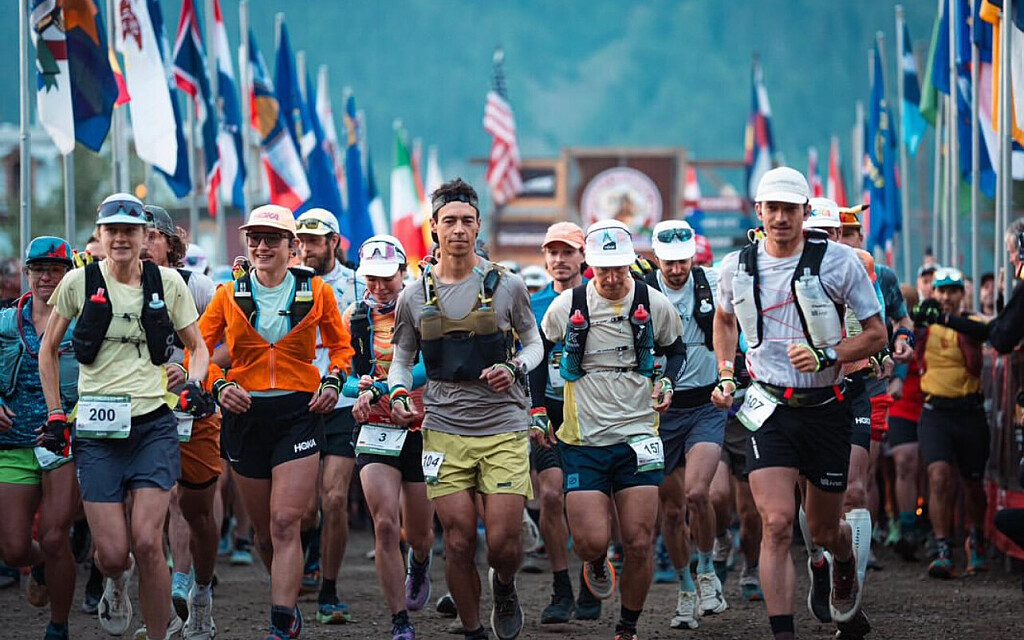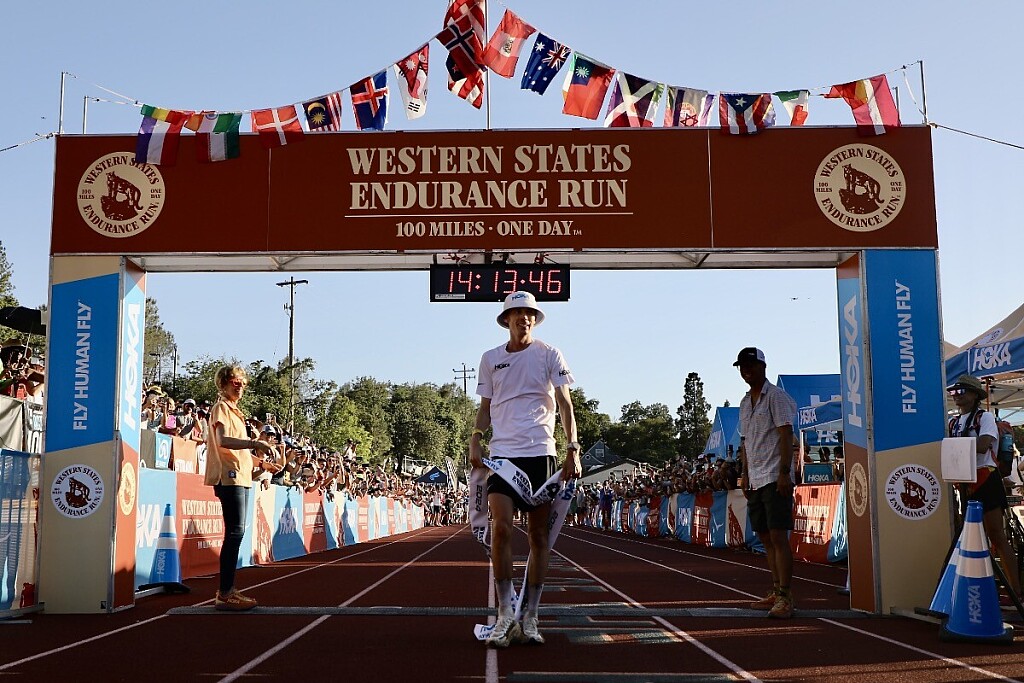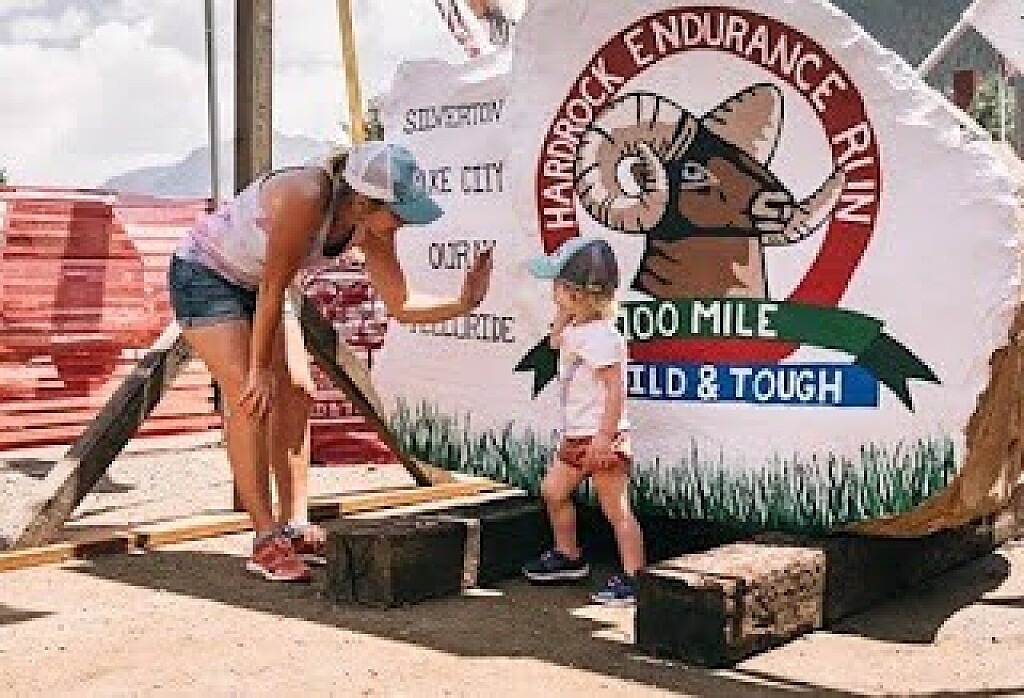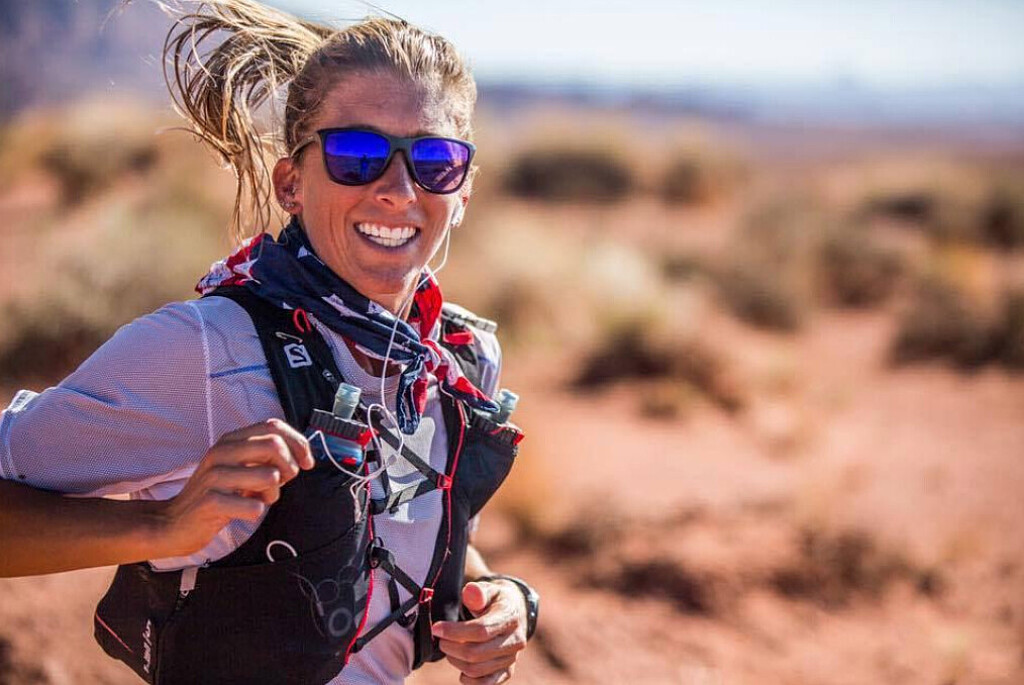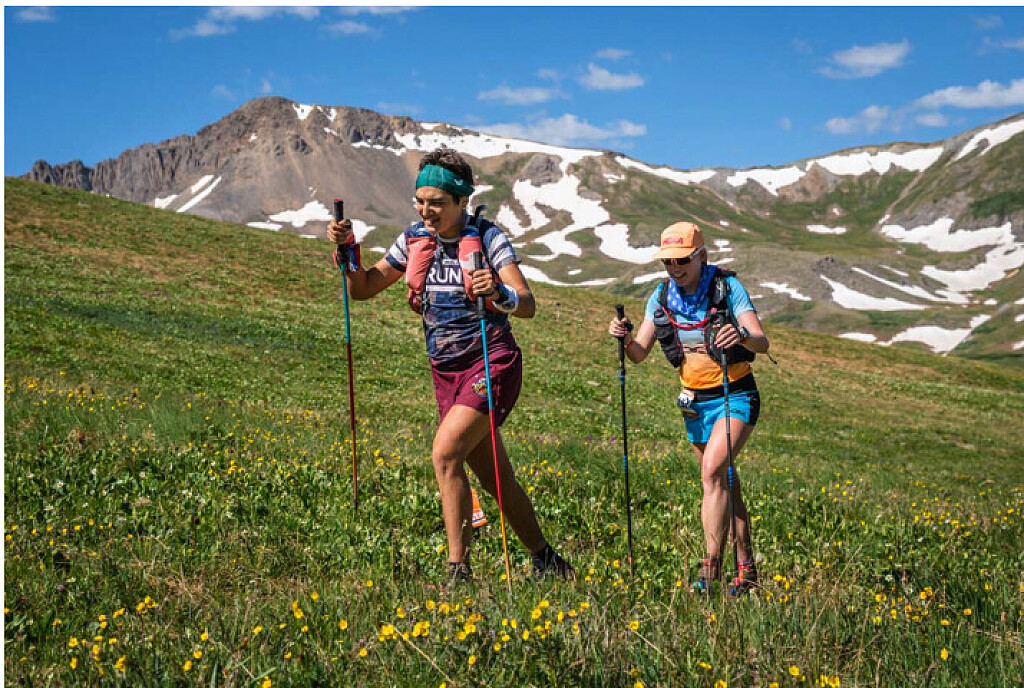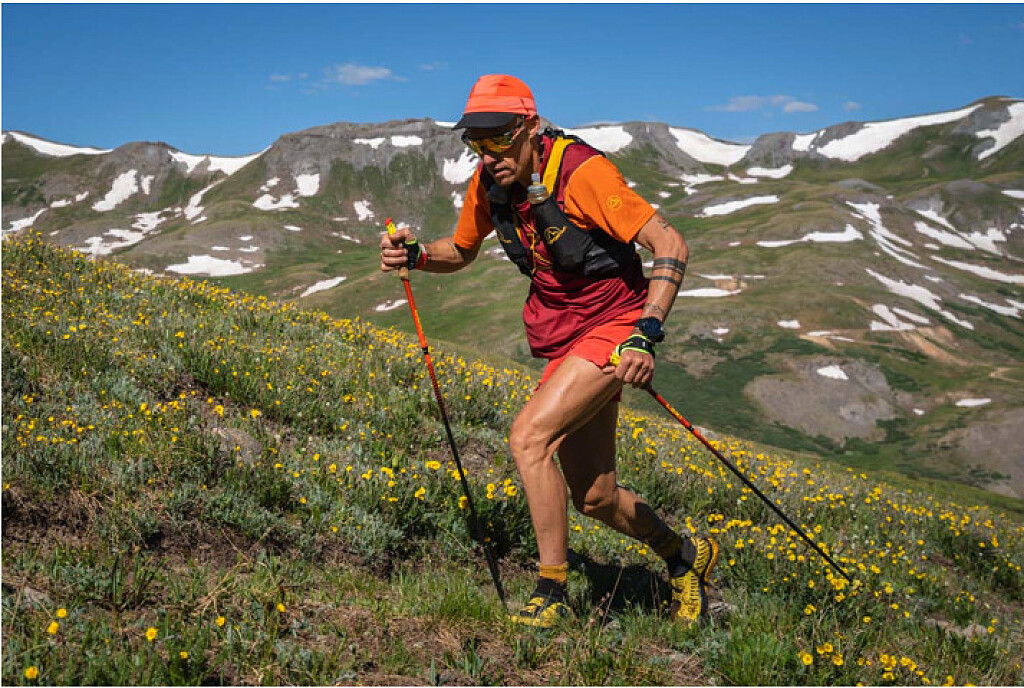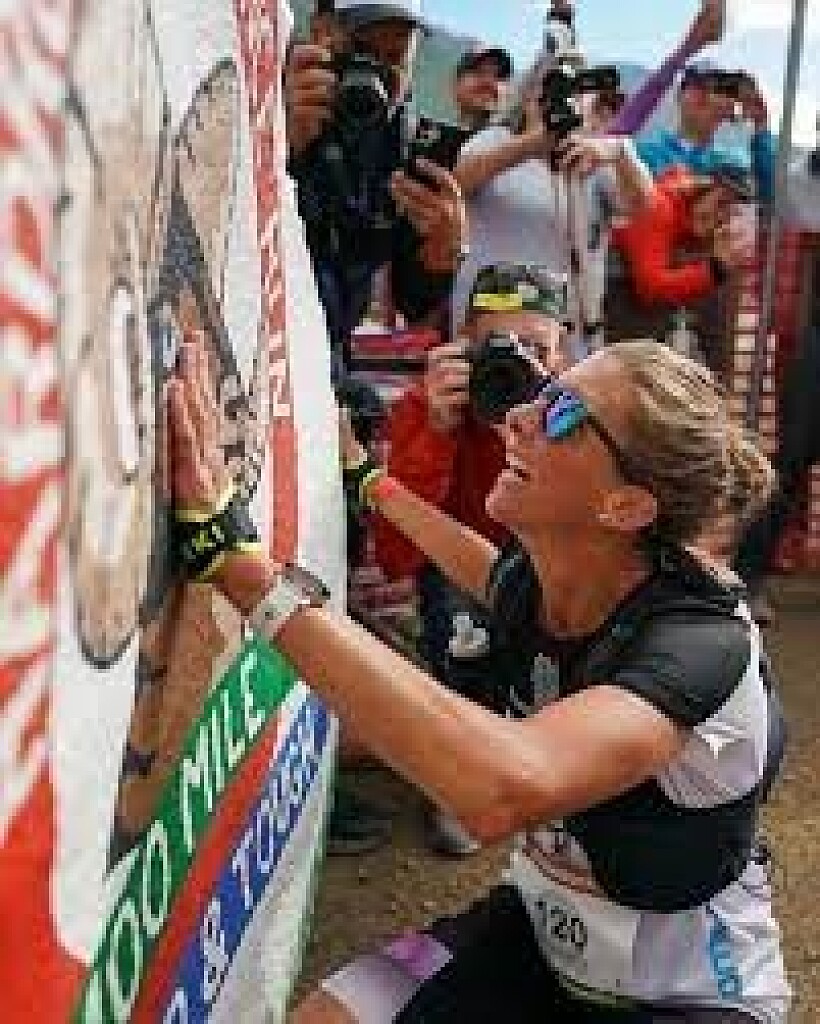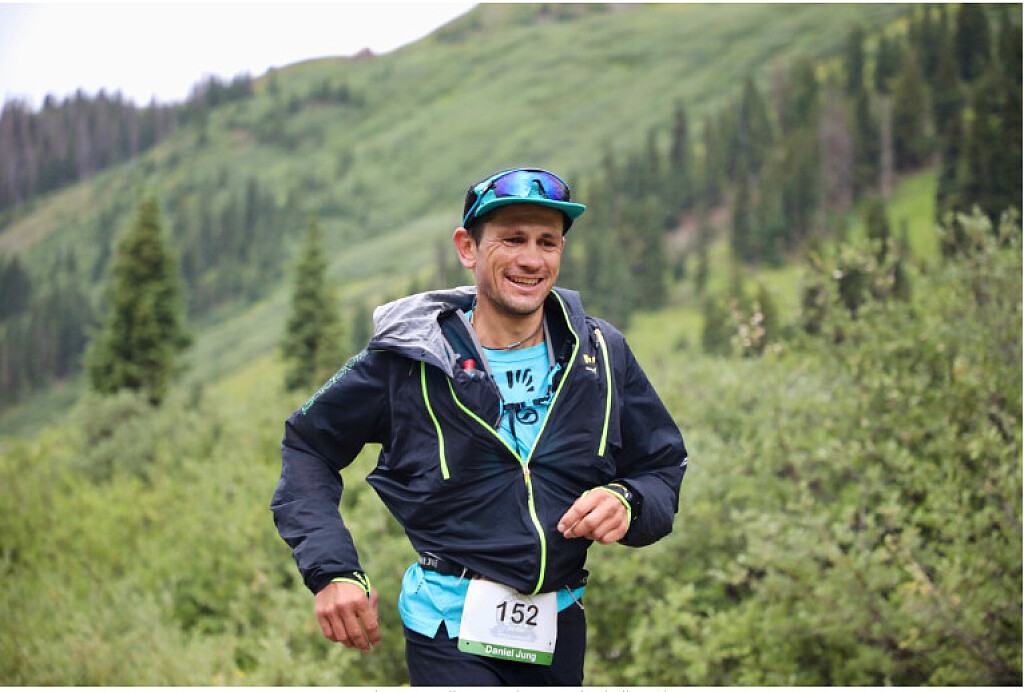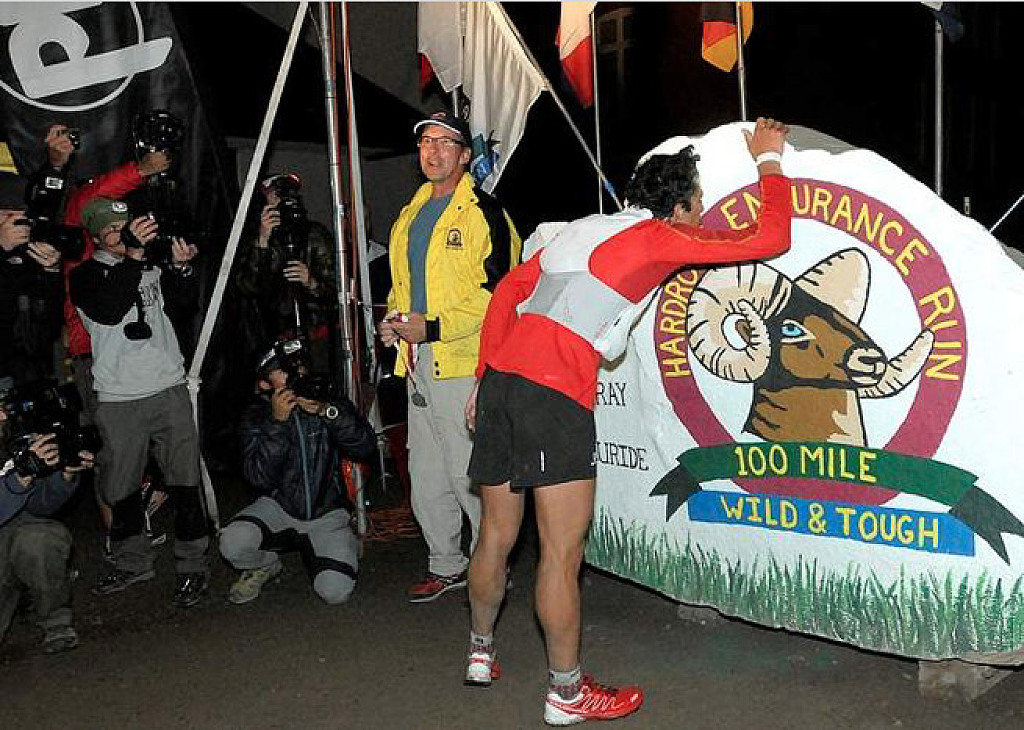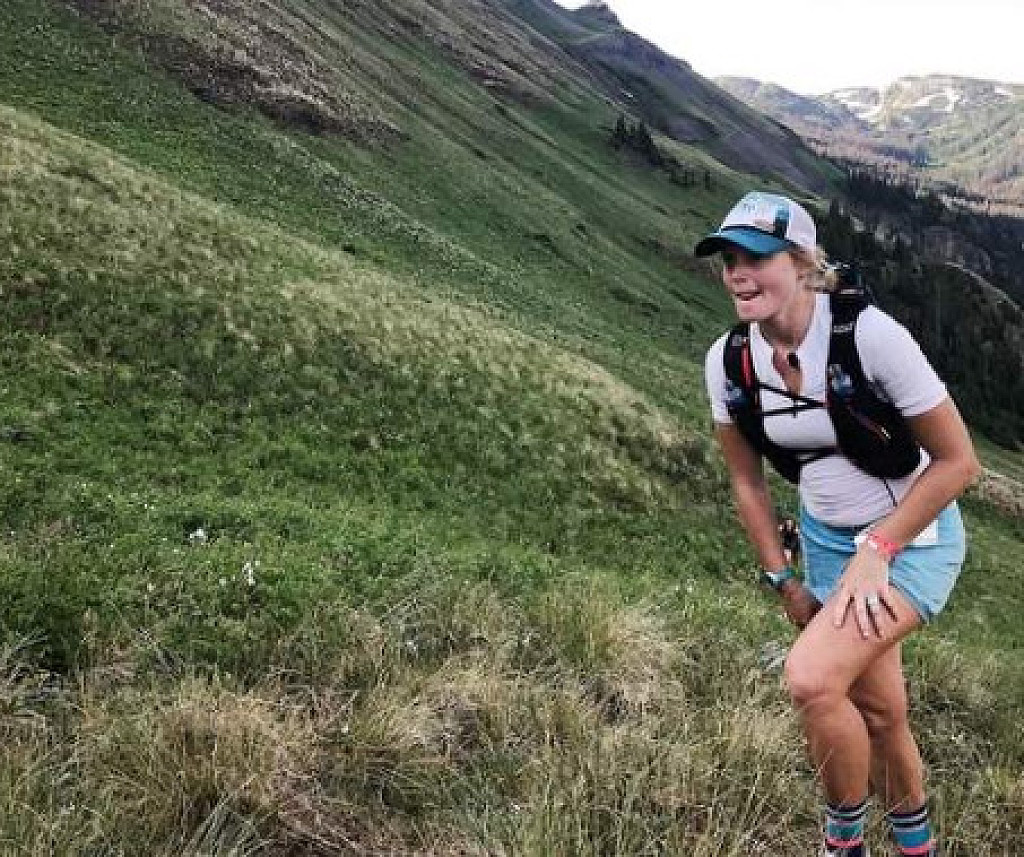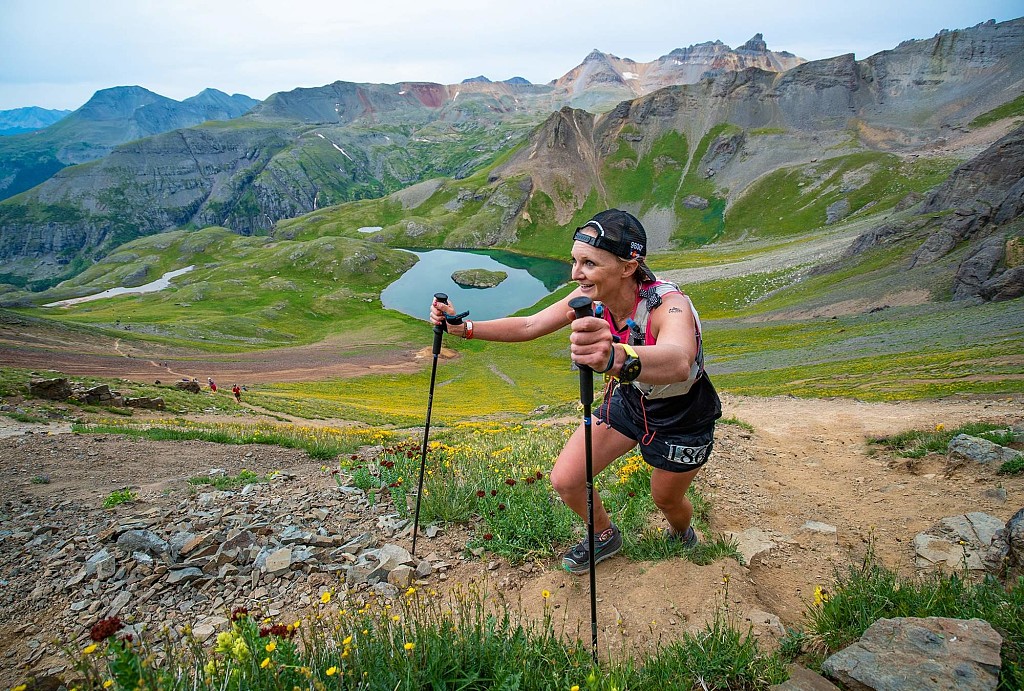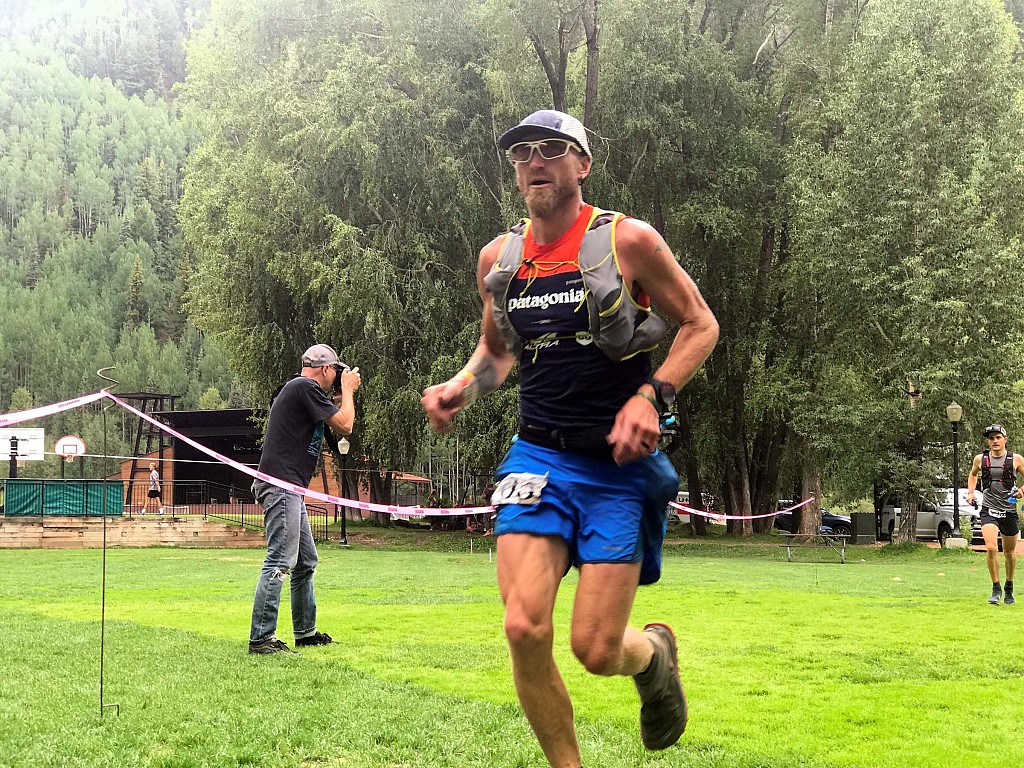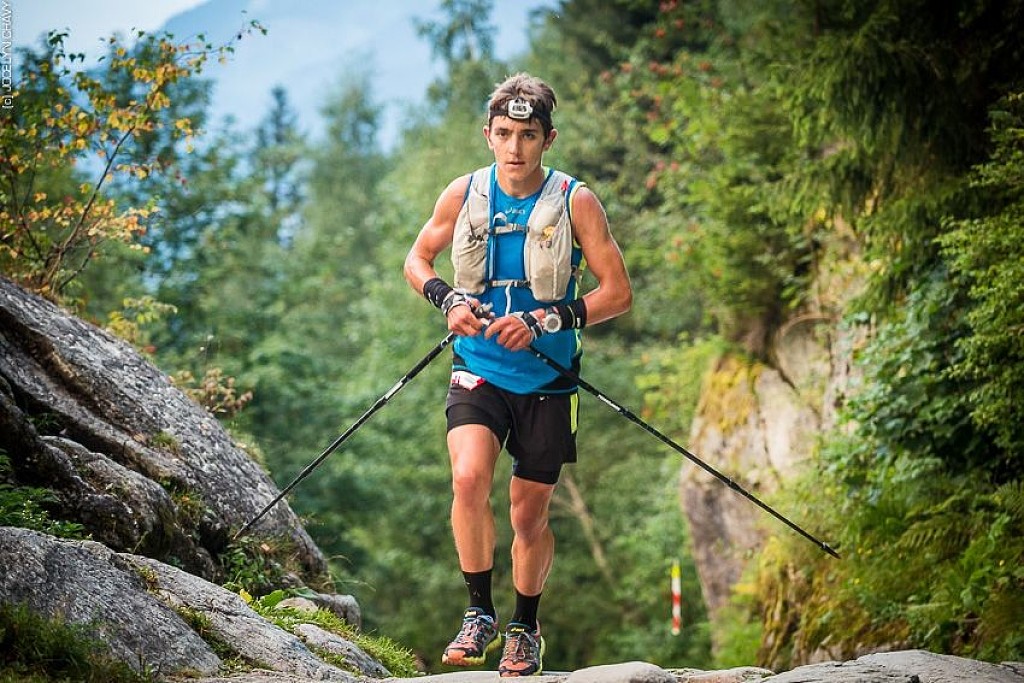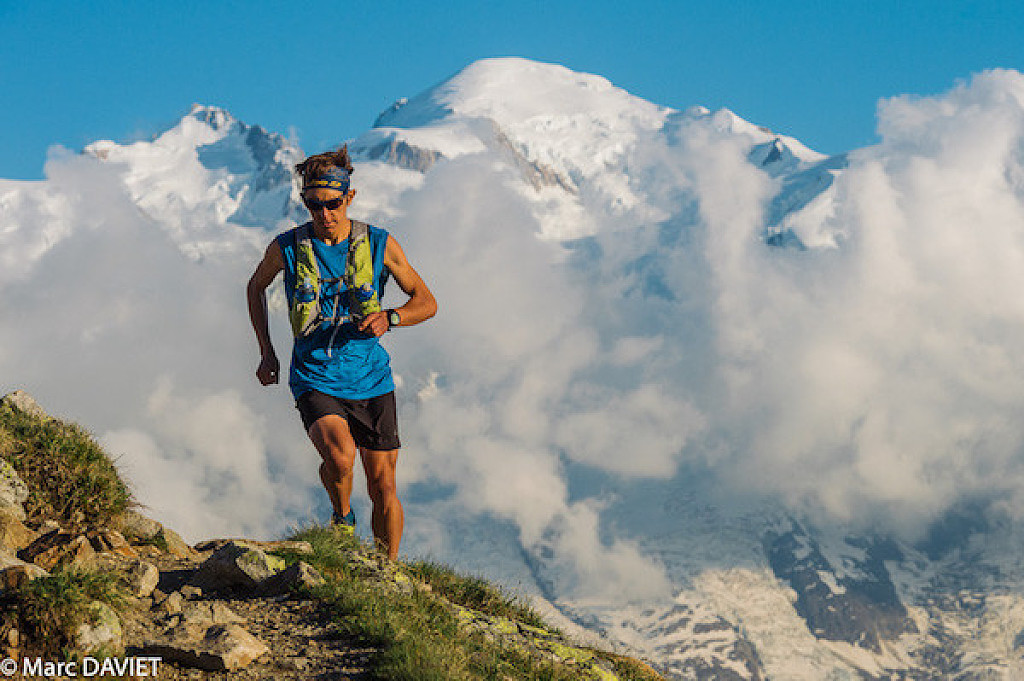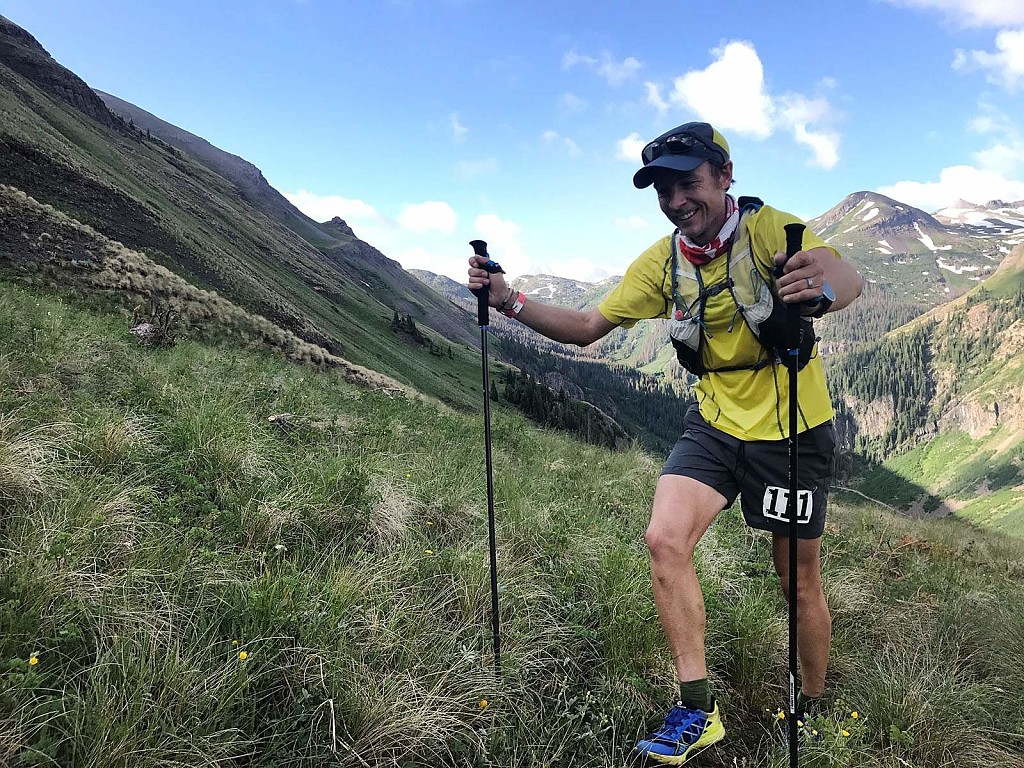Running News Daily
Running News Daily is edited by Bob Anderson. Send your news items to bob@mybestruns.com Advertising opportunities available. Train the Kenyan Way at KATA Kenya and Portugal owned and operated by Bob Anderson. Be sure to catch our movie A Long Run the movie KATA Running Camps and KATA Potato Farms - 31 now open in Kenya! https://kata.ke/
Index to Daily Posts · Sign Up For Updates · Run The World Feed
Ludo Pommeret and Katie Schide Dominate a Gritty 2025 Hardrock 100
The 2025 Hardrock 100 delivered everything the ultra-trail world expects from one of the sport’s most iconic races—grit, altitude, heartbreak, and triumph. At the heart of it all, France’s Ludovic “Ludo” Pommeret successfully defended his title, while American ultra star Katie Schide shattered the women’s course record.
Pommeret Goes Back-to-Back
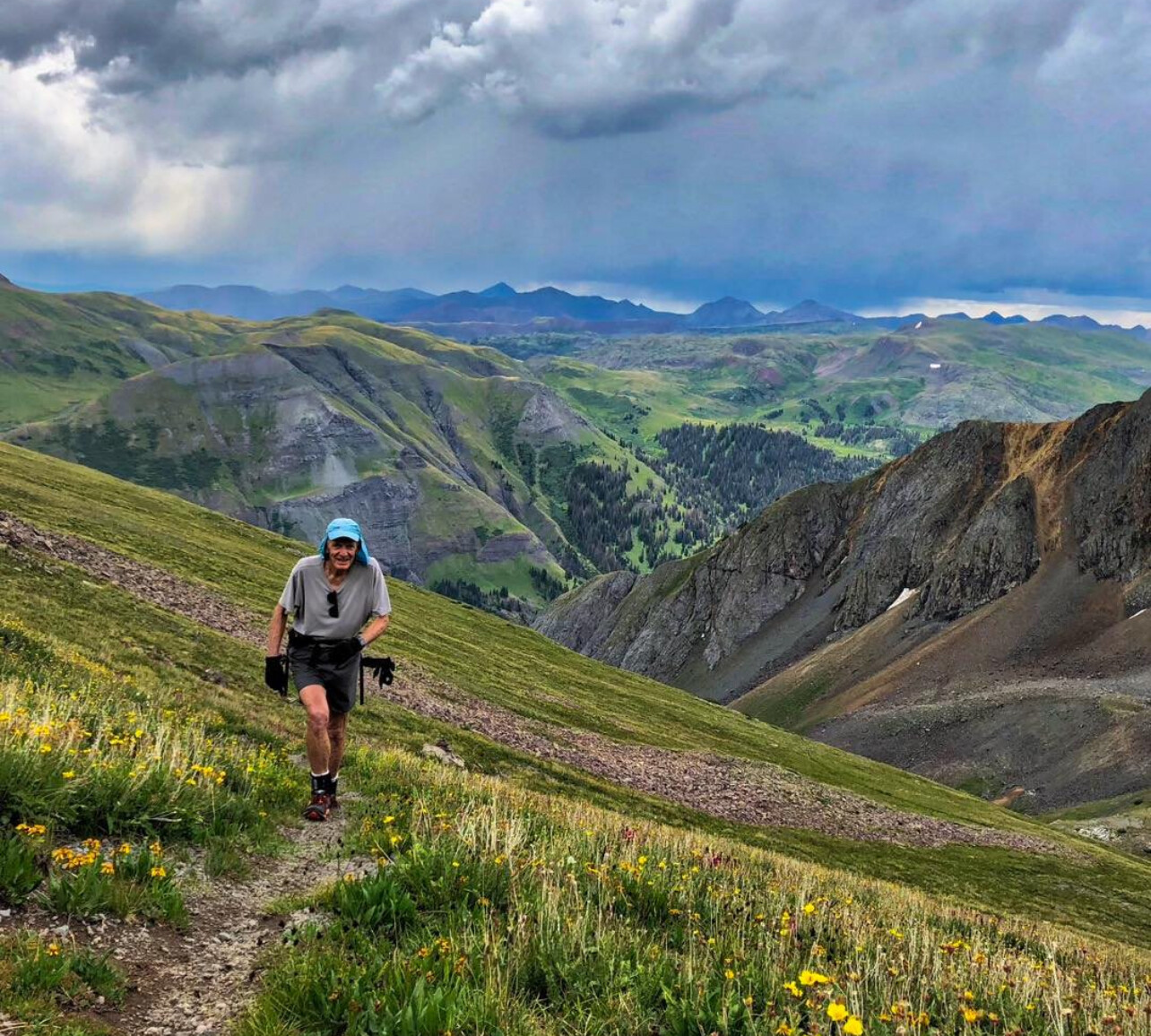
For the second year in a row, the 49-year-old Pommeret conquered the brutal 102.5-mile loop through Colorado’s San Juan Mountains, finishing in 22:21:55—the fifth-fastest time in race history. Battling thin air, smoky conditions from nearby wildfires, and rugged terrain with over 33,000 feet of elevation gain, Pommeret executed a masterclass in pacing.
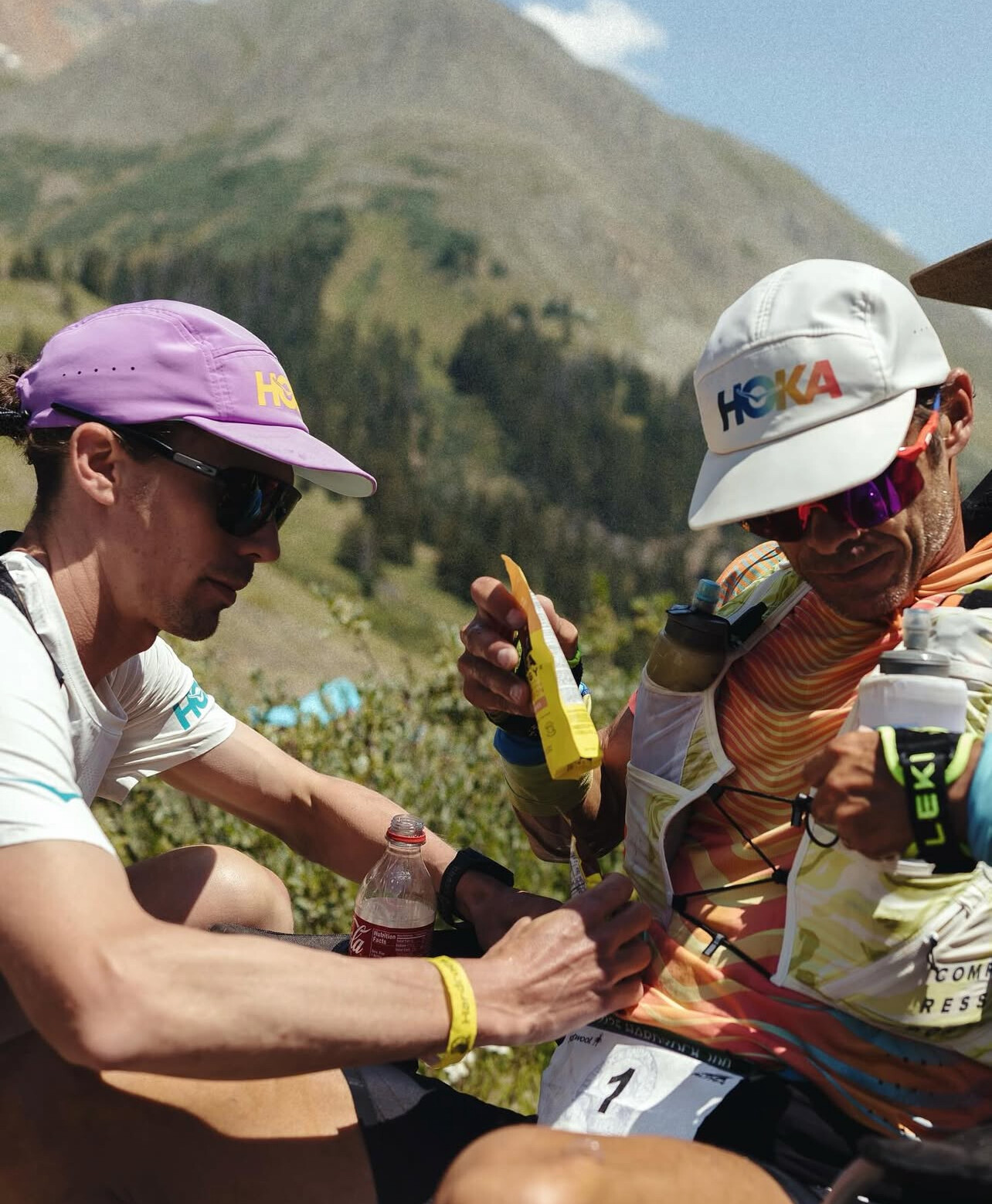
Starting conservatively on the climbs, he surged on the descents, aided by elite pacers Jim Walmsleyand Vincent Bouillard. By dawn, he had extended his lead and cruised into Silverton well under the 48-hour cutoff, earning another coveted kiss of the Hardrock finish-line rock.
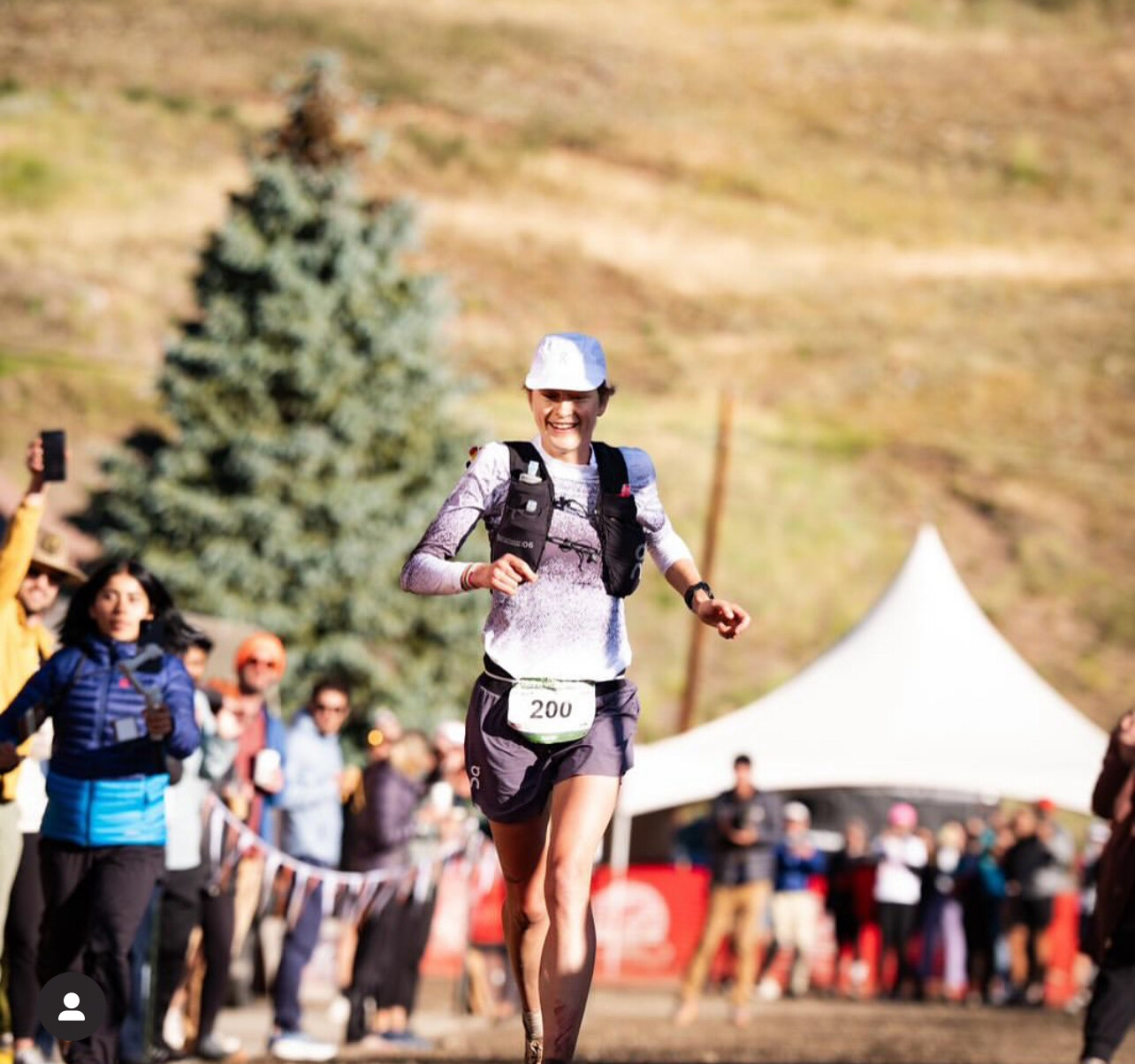
The men’s podium was a French sweep: Mathieu Blanchard placed second in 23:44, followed by Germain Grangier in 24:04.
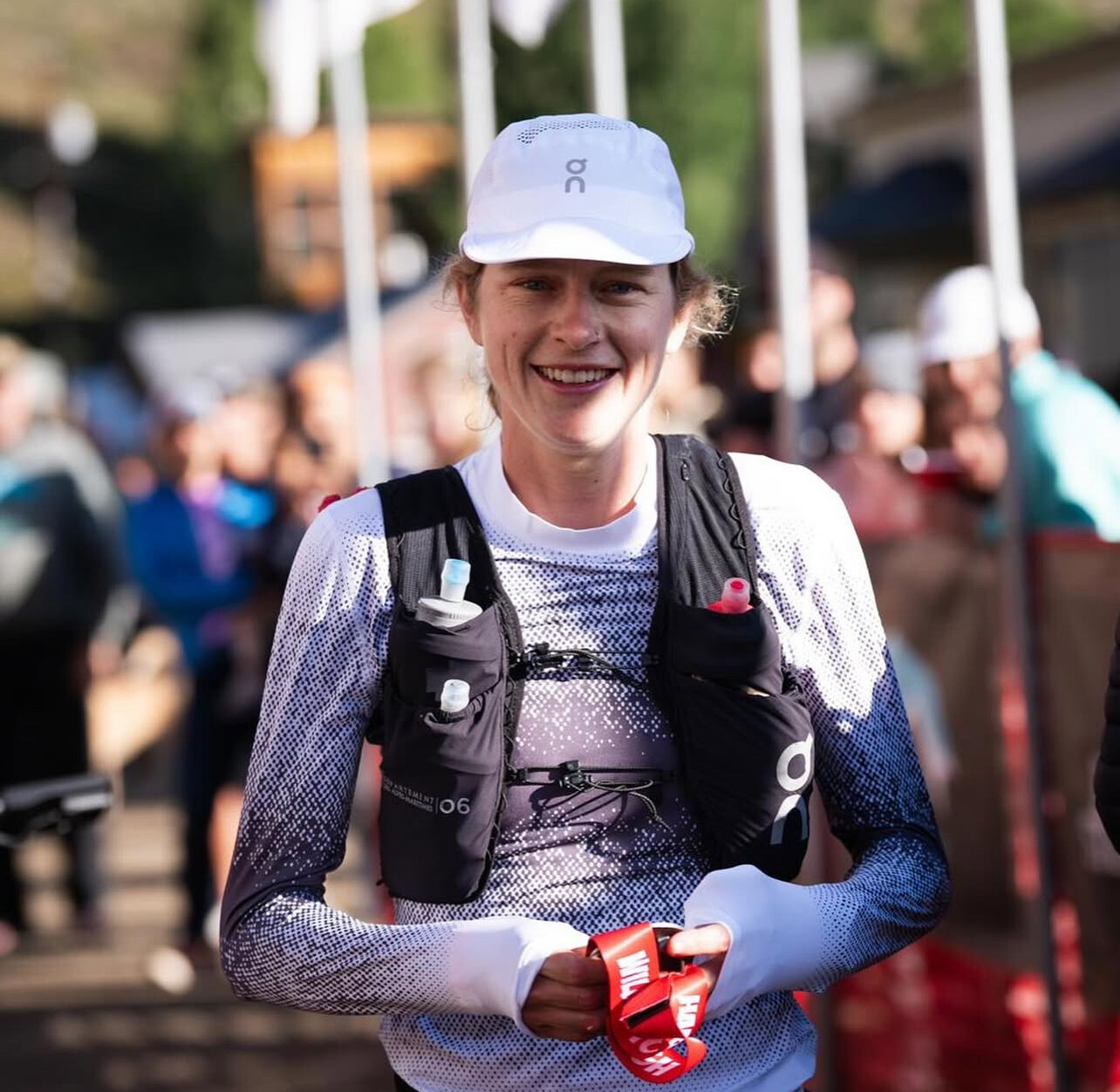
“I was worried about the smoke early on,” Pommeret said afterward, “but the final miles were magic. I even walked the last climb to take it all in.”

Schide Smashes Course Record
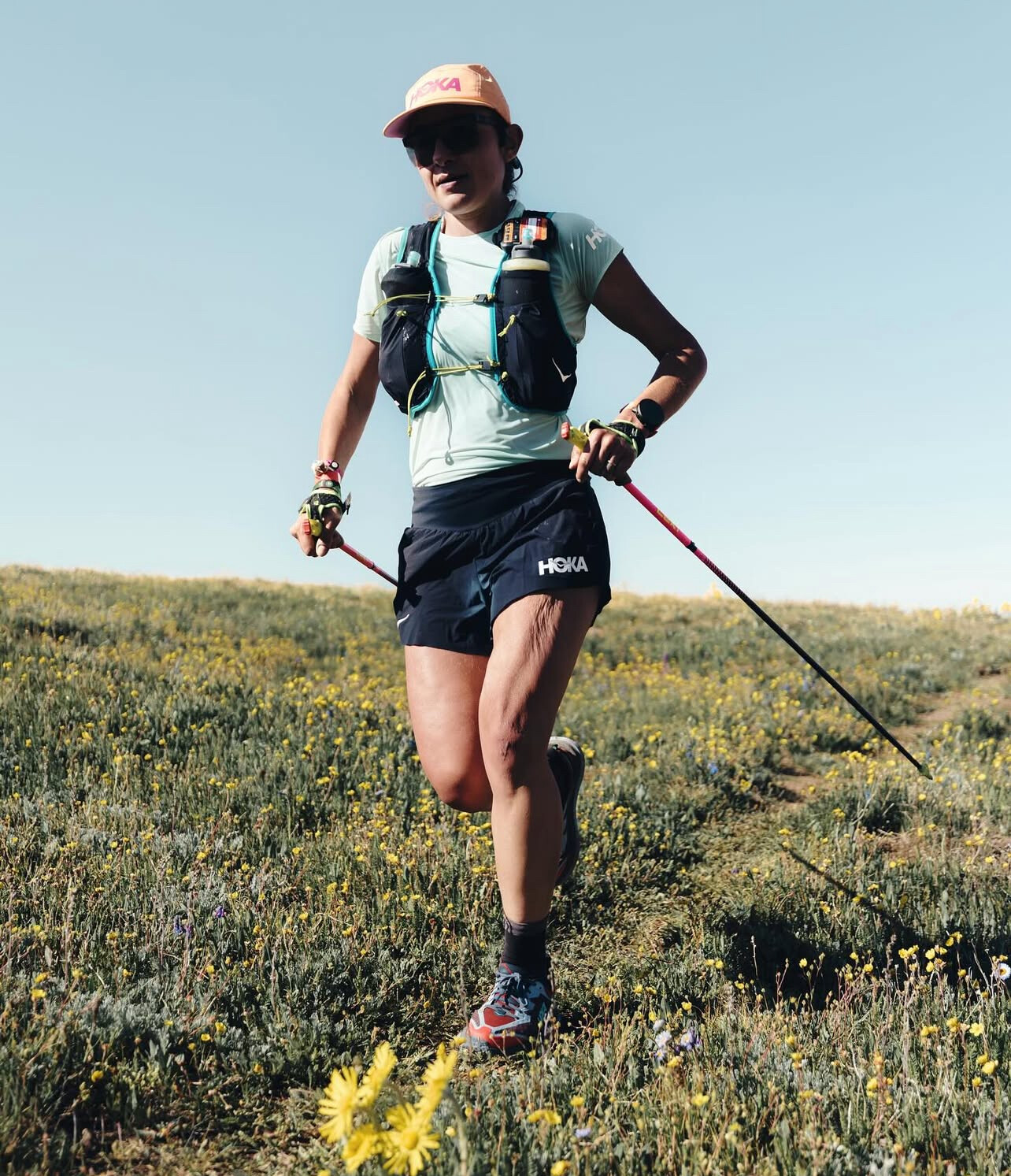
In the women’s race, Katie Schide delivered one of the most commanding performances in Hardrock history, crossing the finish in 25:50—the fastest counterclockwise time ever on this course. Her effort redefined what’s possible on one of the toughest 100-milers in the world, solidifying her place among the sport’s elite.
A Somber Note
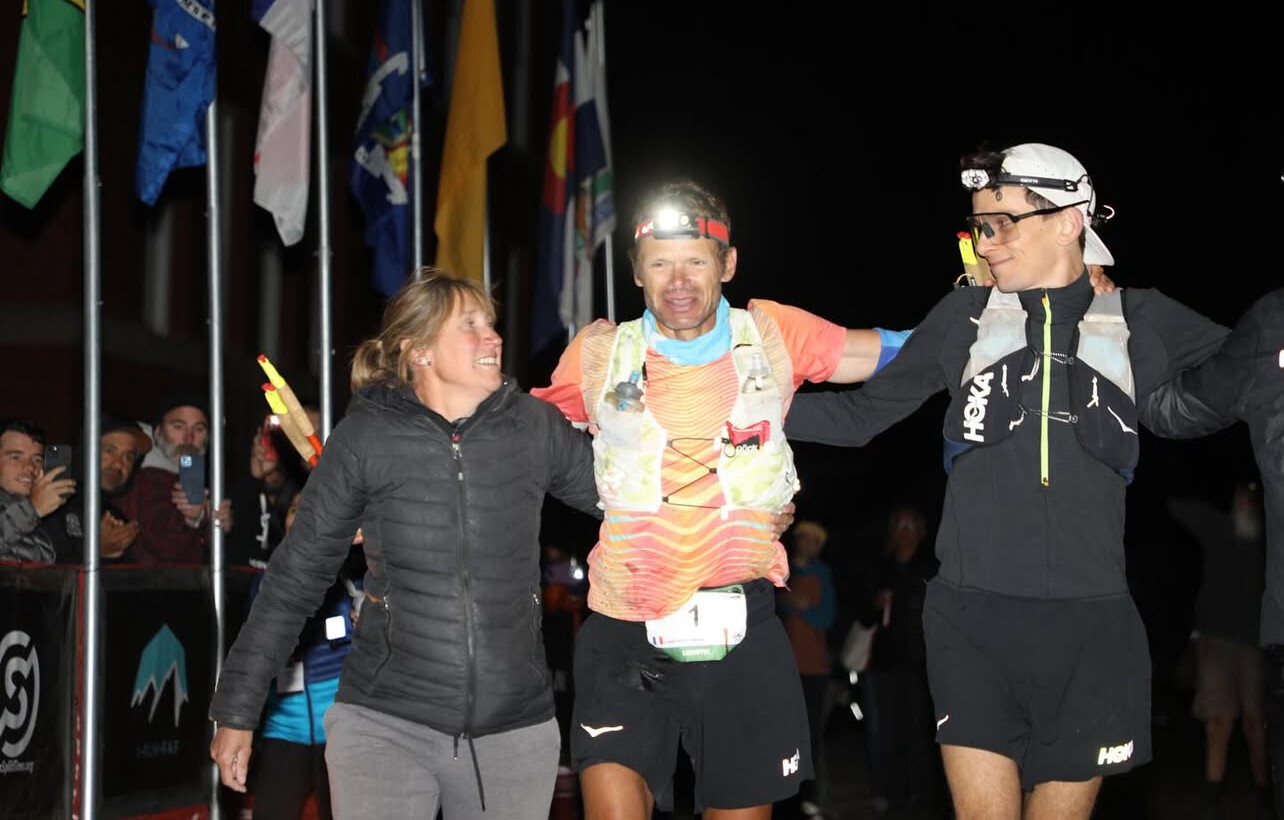
The celebration was tempered by tragedy. One of the 146 starters, 60-year-old Elaine Stypula, passed away early in the race. The trail community paused to honor her memory, a reminder of both the beauty and the inherent risk of this extreme pursuit.
Why This Race Matters
• Age is just a number: At nearly 50, Pommeret continues to perform at the highest level, adding another major title to a résumé that includes victories at UTMB (2016) and Diagonale des Fous (2021).
• Trail’s toughest test: With extreme elevation, altitude averaging over 11,000 feet, and no room for error, Hardrock remains a crucible for the toughest athletes on Earth.
• Global competition: With a French men’s podium and an American record-breaker, the international caliber of this year’s race underscored its global significance.
2025 Hardrock 100 Key Results
|
Category |
Winner |
Time |
|
Men’s Champion |
Ludovic Pommeret |
22:21:55 |
|
Women’s Champion |
Katie Schide |
25:50 (course record) |
|
Men’s 2nd |
Mathieu Blanchard |
23:44 |
|
Men’s 3rd |
Germain Grangier |
24:04 |
|
|
|
|
With record-breaking performances and powerful moments of perseverance, the 2025 Hardrock 100 once again proved why it’s one of the most respected races in the world of ultrarunning.
by Boris Baron
Login to leave a comment
Hardrock 100
100-mile run with 33,050 feet of climb and 33,050 feet of descent for a total elevation change of 66,100 feet with an average elevation of 11,186 feet - low point 7,680 feet (Ouray) and high point 14,048 feet (Handies Peak). The run starts and ends in Silverton, Colorado and travels through the towns of Telluride, Ouray, and the ghost town...
more...Western States 100: Walmsley Wins a Fourth Time While Schide Rocks the Women’s Field
For hours, Katie Schide (pre-race and post-race interviews) chased ghosts. For hours, Jim Walmsley (pre-race and post-race interviews) and Rod Farvard (post-race interview) chased each other. And in the end, after 100 courageous, gutsy miles at one of the world’s most iconic ultramarathons, it was Schide and Walmsley who won a fast, dramatic 2024 Western States 100.
Schide, an American who lives in France, was on pace to break the course record until late in the race, while Americans Walmsley and Farvard battled throughout most of the second half of the race, alternating the lead as late as mile 85.
Schide’s winning time was 15:46:57, just over 17 minutes behind Courtney Dauwalter’s 2023 course record, almost an hour faster than her own time last year, and the second fastest women’s time ever. Walmsley, meanwhile, won his fourth Western States in 14:13:45, the second fastest time ever — only behind his own record of 14:09:28 that he set in 2019.
Second and third in the men’s race came down to an epic sprint finish on the track between Farvard and Hayden Hawks (pre-race and post-race interviews), who finished in 14:24:15 and 14:24:31, respectively.
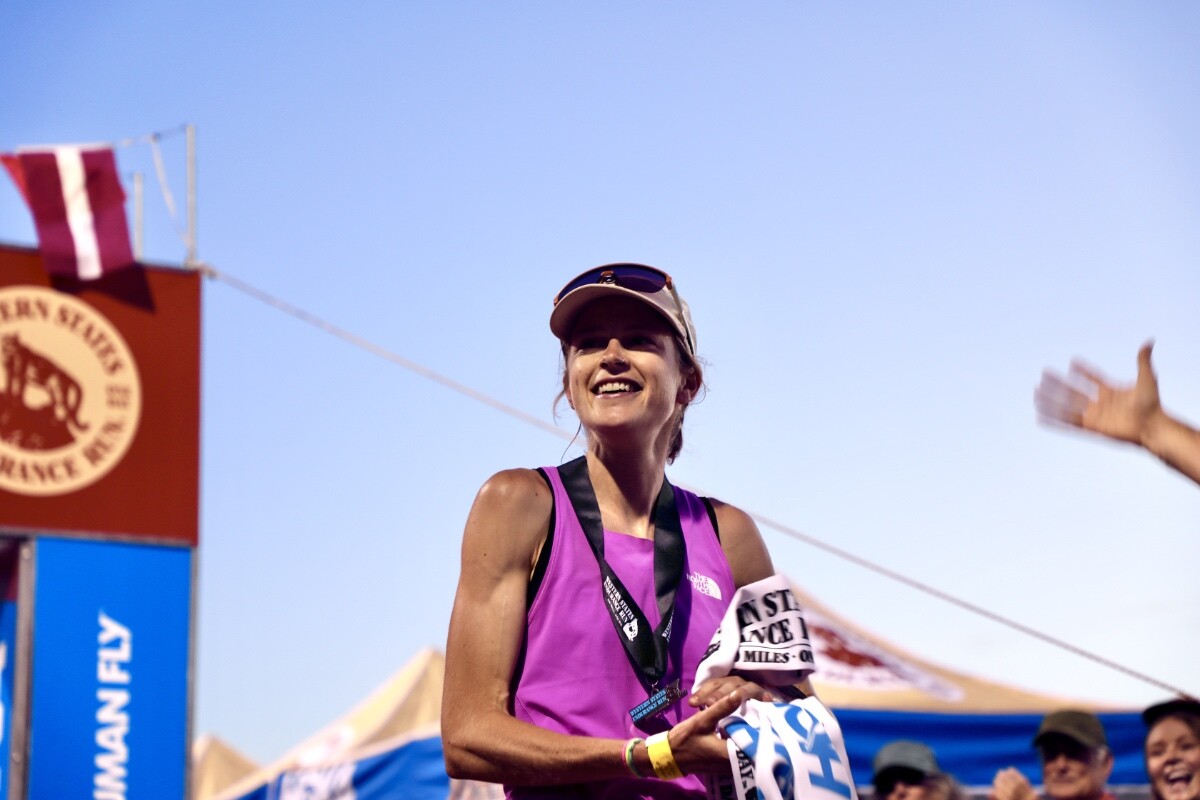
In the women’s race for the podium, Fu-Zhao Xiang (pre-race and post-race interviews) finished second in 16:20:03, and Eszter Csillag (pre-race and post-race interviews) took third for the second time in a row, in 16:42:17.
Both races featured one of the deepest and most competitive fields in race history, with the men’s top five all coming in faster than last year’s winning time, and the women’s top 10 finishing just under 40 minutes faster than last year’s incredibly competitive top 10.
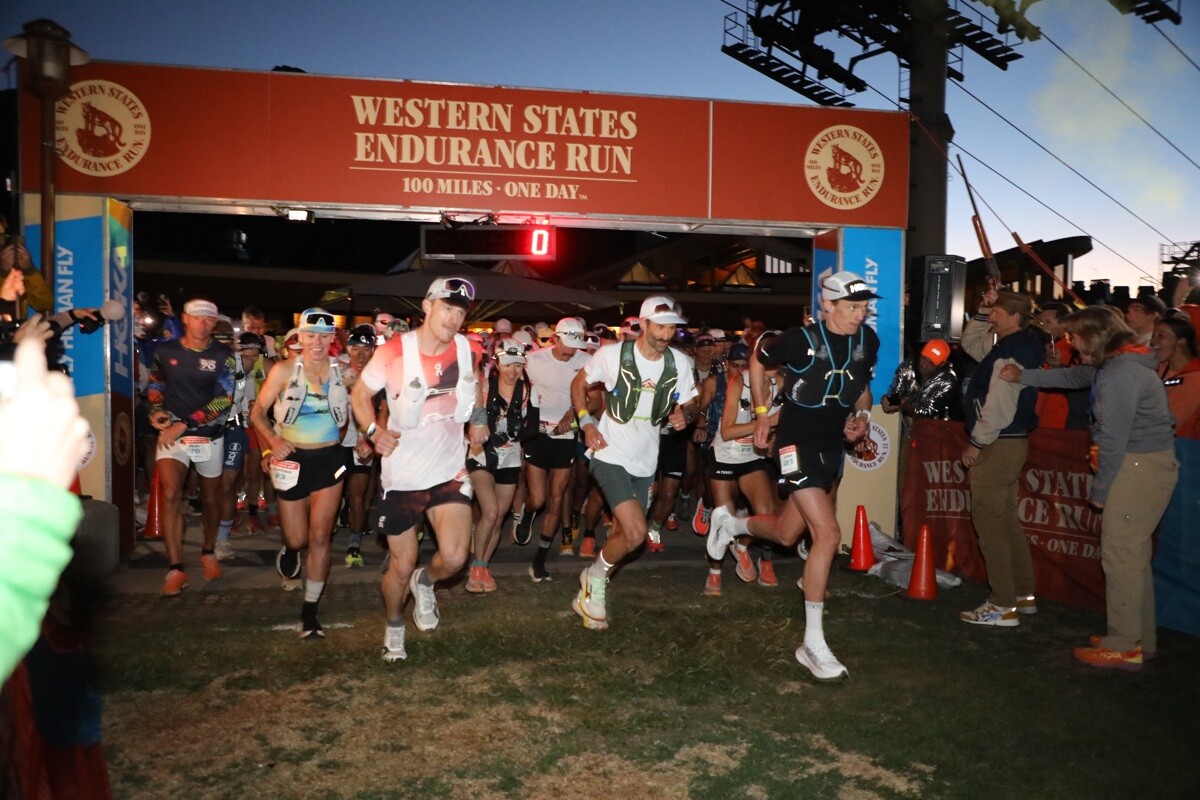
At 5 a.m. on Saturday, June 29, they were all among the 375 runners who began the historic route from Olympic Valley to Auburn, California, traversing 100.2 miles of trail with 18,000 feet of elevation gain and 22,000 feet of loss. After last year’s cool temperatures, the weather at this year’s race was a bit warmer, albeit with a notable lack of snow in the high country. The high temperature in Auburn was in the low 90s Fahrenheit.
A special thanks to HOKA for making our coverage of the Western States 100 possible!
2024 Western States 100 Men’s Race
In his return to the race that propelled him to the heights of global trail running and his first ultra on American soil in three years, Jim Walmsley (pre-race interview) demonstrated why he is, once again, the king of Western States. Before the race, Walmsley exuded a calmness that perhaps eluded him during his first attempts, when he attacked it with an obsessive intensity that led him to famously take a wrong turn and then dropping out in back-to-back years.
“We’ll just roll with what plays out and just kind of see what happens in the race,” he said in his pre-race interview. There’s a marked difference when compared to his remarks from his interview before the 2016 race.
What happened in the race was this: In his fourth Western States, Rod Farvard (post-race interview) had the race of his life to push Walmsley like he’d never been pushed before in his long history with the event.
Farvard — a 28-year-old from Mammoth Lakes, California, who has improved his finish each year at the race, from a DNF in 2021 to 41st place in 2022 to 11th place last year — put himself in a strong position from the start, leading a large pack of runners that included Walmsley at the top of the Escarpment, the 2,500-foot climb in the first four miles of the race. For the next 45-plus miles, Farvard remained in the top 10, part of a chase pack of American Hayden Hawks (pre-race and post-race interviews), Kiwi Dan Jones (pre-race interview), and Chinese runner Guo-Min Deng, among others.
At the Robinson Flat aid station at mile 30 — the symbolic end of the runners’ time in the high country, which features an average elevation of around 7,000 feet — Walmsley, who started the race conspicuously wearing all black, came through in 4:24 looking fast and smooth, now wearing an ice-soaked white shirt. Jones, the 2024 Tarawera 102k champion and fifth-place finisher in his Western States debut last year, and Hawks, who set the course record at February’s Black Canyons 100k after dropping out of last year’s Western States, followed about 90 seconds later. The two runners, frequent training partners, ran together frequently throughout the day, with Hawks often foregoing ice at aid stations.
After the trio of Walmsley, Hawks, and Jones went through Last Chance at mile 43 together, Walmsley put nearly two minutes on them up the climb to Devil’s Thumb. “I was with everybody at the bottom,” he said, according to the race’s official livestream.
About halfway through, at mile 49.5, the order remained the same: Walmsley in the lead with an elapsed time of 6:58, followed by Jones one minute back, Hawks two minutes back, and Farvard just over two and a half minutes back. The rest of the top 10 were last year’s 17th-place finisher Dakota Jones; 2024 Transvulcania Ultramarathon champion Jon Albon (pre-race interview), who is from the U.K. but lives in Norway; 2023 fourth-place finisher Jia-Sheng Shen (China) (pre-race interview); 2023 Canyons 100k champion Cole Watson; Western States specialist Tyler Green (pre-race interview); and Jupiter Carera (Mexico).
Then began a thrilling, chaotic second half of the race — featuring a gripping back-and-forth between Walmsley and Farvard, a wildfire near the course, a two-man river crossing, and a sprint finish on the track.
It all started when Walmsley entered Michigan Bluff at mile 55, again looking calm and in control, changing shirts and getting doused with ice. Farvard came in just behind him and left the aid station first, leading the race for the first time since the first climb up the Escarpment. The same routine took place seven miles later at Foresthill: Walmsley entering first, Farvard leaving first.
For the next 18 miles, the two runners alternated in the lead. By mile 78, they were so close that they were crossing the American River at the same time. Their battle underscored the overall depth of the field at this year’s race: At mile 80, the top five men were within 16 minutes of one another.
Around then, the 15-acre Creek Fire, which started not long before, was visible from the final quarter of the course and crews were temporarily not permitted to travel to the Green Gate aid station at mile 80 because the route to it passed close to the fire. Eventually, a reroute was established for crews to get to Green Gate and, later, after the wildfire was controlled, the regular route was reopened.
At Green Gate, Farvard came through in the lead, with Walmsley four minutes back and looking like he was hurting. It was then, perhaps, that the thought entered people’s minds: Could Farvard really take down the champ?
But Jim Walmsley is Jim Walmsley for a reason, and he again proved why he is among the world’s best. Against the ropes, facing one of his first real challenges in the race that shaped him, he delivered, entering the next aid station, Auburn Lake Trails at mile 85, more than a minute earlier than Farvard. He had made up five minutes in five miles.
Walmsley never trailed again, increasing his lead to 11 minutes by the Pointed Rocks aid station at mile 94 and then picking up his crew, including his wife, Jess Brazeau, at Robie Point to run the final mile with him. He entered the track at Placer High School to loud cheers, his loping stride still looking smooth, stopping a few steps short of the tape to wave to the crowd and raise his arms in triumph. He had done it again.
Behind him, Farvard was fading but determined to cap an extraordinary race with a second-place finish. Hawks, who had made up five minutes on Farvard in the couple miles between Pointed Rocks and Robie Point, was on the hunt, and by the time he stepped on the track, Farvard was within sight.
It was then that fans were treated to one of the most unique sights in all of ultrarunning: After 100 miles of racing, two men were sprinting against each other on a track. In the end, Farvard’s lead held, and he finished 16 seconds ahead of Hawks. He collapsed at the finish line — a fitting end to an epic performance.
Dan Jones ended a strong race with a fourth-place finish in 14:32:29, with Caleb Olson capping an impressive second half of the race — from 11th at mile 53 to fifth in 14:40:12 at the finish. All five men ran a time that would have won the race last year.
Behind Olson came Jon Albon, running 14:57:01 in his 100-mile running-race debut, followed by the surgical Tyler Green, who finished in seventh for his fourth straight top 10 finish at the race. Green’s time of 15:05:39 also marked a new men’s masters course record, breaking the 2013 Mike Morton record of 15:45:21.
Rounding out the top 10 were Jia-Sheng Shen in eighth with a time of 15:09:49, Jonathan Rea in ninth who methodically moved his way up during the last 60 miles to finish in 15:13:10; and Chris Myers in 10th in 15:18:25.
2024 Western States 100 Women’s Race
Through the high country, into and out of the canyons, and along the river of the world’s oldest 100-mile trail race, Katie Schide (pre-race and post-race interviews) raced only the ghosts of the clock and history. Smiling throughout, she seemed unaffected by the solitude and the enormity of the possibility that lay before her: to attempt to break the course record of one of the world’s most iconic trail races.
Schide, an American who lives in France, came into the race as the clear favorite, and for good reason: She finished second last year, breaking Ellie Greenwood’s previously untouchable 2012 course record by more than three minutes and losing to only Courtney Dauwalter, who broke Greenwood’s record by an astounding 78 minutes on her way to a historic Western States-Hardrock 100-UTMB triple win. Schide, winner of the 2022 UTMB and 2023 Diagonale des Fous 100 Mile, spent the last two-and-a-half months in Flagstaff, Arizona, training for Western States, winning this year’s Canyons 100k in an impressive tune-up and putting in a monster training block.
In her pre-race interview, Schide said that she had thought about ways to improve her race from last year, which perhaps should have been the first warning to her competition. The second, then, was her immediate separation from the women’s chase pack: She summited the Escarpment, a 2,500-foot climb during the first four miles, in first place and never looked back. By the first aid station — Lyon Ridge at 10 miles — she was already 12 minutes under course record pace, and by Robinson Flat at mile 30, she was 21 minutes ahead of second-place Emily Hawgood (pre-race interview), from Zimbabwe but living in the U.S.
The lead only ballooned from there. By Dusty Corners at mile 38, Schide was an incredible 26 minutes under course record pace, and though she lost a few minutes from that pace by the time she climbed up to Michigan Bluff at mile 55, her smile had not waned even slightly. She smoothly entered the iconic aid station, doused herself with ice, changed shirts, and was soon on her way. She never sat down.
Twenty-seven minutes behind her was Hawgood, looking to build on back-to-back fifth-place finishes. Eszter Csillag (pre-race and post-race interviews), a Hungarian who lives in Hong Kong, followed soon after, in the same third spot she finished in last year.
After them ran a dense pack of women: Only 16 minutes separated Hawgood in second from Lotti Brinks in 11th.
At the halfway point, the top 10 were Schide, 33 minutes up in an elapsed time of 7:26; Csillag; Hawgood; Chinese runner Fu-Zhao Xiang (pre-race and post-race interviews), the fourth-place finisher at last year’s UTMB; Lin Chen (China); American Heather Jackson, a versatile former triathlete who recently finished fifth at a competitive 200-mile gravel bike race; ultrarunning veteran Ida Nilsson (pre-race interview), a Swede living in Norway; Becca Windell, second in this year’s Black Canyon 100k; 2023 CCC winner Yngvild Kaspersen (Norway); and Rachel Drake, running her 100-mile debut.
Schide, easily identifiable in her pink shirt, maintained her large lead throughout the second half of the race, remaining calm, controlled, and upbeat throughout the tough canyon miles. By Foresthill at mile 62, she was 19 minutes ahead of course record pace and 48 minutes ahead of the second-place Xiang. Schide’s stride still looked smooth as she waved to fans and even high-fived a cameraman.
Schide’s aggressive pace eventually slowed — by Green Gate at mile 80, her lead on the course record had dissipated — but her spirits did not. After a quick sponge bath at Auburn Lake Trails aid station at mile 85, she fell behind course-record pace for the first time all day, only 15 miles remained until the finish.
Schide entered the track a couple of hours later, running with her crew and no headlamp. She would finish before dark. She stopped for a hug on the final straightaway and lifted the tape with, of course, a smile.
Xiang had methodically pulled away from Hawgood and Csillag during an incredibly strong second half to win the battle for second. Fu-Zhao Xiang finished in 16:20:03 for the third fastest time in race history. Chen, who dropped out at mile 78, was one of the few elite runners who had a DNF on this day, which was categorized by a lack of attrition in both the women’s and men’s elite races.
Eszter Csillag came in about 22 minutes behind Xiang in 16:42:17 for her second consecutive third-place finish, a 30-minute improvement from last year — a statistic that perhaps exemplifies the speed of this year’s race better than any other.
The battle for fourth and fifth was nearly as close as Farvard and Hawks’s race for second in the men’s race a couple of hours earlier.
At Pointed Rocks at mile 94, Hawgood led by barely two minutes, running hard and straight through the aid station. Kaspersen, meanwhile, was drinking Coke and made up almost a minute by Robie Point.
Emily Hawgood’s lead ultimately held, and she finished fourth in 16:48:43 to improve her finish from prior years by one spot. Yngvild Kaspersen was less than two minutes back in 16:50:39. Ida Nilsson capped a strong day to finish sixth in 16:56:52 and break Ragna Debats’s masters course record by almost 45 minutes. That means the top six women all finished in under 17 hours in a race that had only ever had three women finish under that mark — and two of them, Dauwalter and Schide, were last year.
The rest of the top 10 were Heather Jackson in seventh in 17:16:43, and, in close succession, Rachel Drake in 17:28:35, Priscilla Forgie (Canada) in 17:30:24, and Leah Yingling in 17:33:54.
The top 10 women were all faster than the 12th-fastest time in race history going into the day.
by Robbie Harms
Login to leave a comment
Hardrock 100
100-mile run with 33,050 feet of climb and 33,050 feet of descent for a total elevation change of 66,100 feet with an average elevation of 11,186 feet - low point 7,680 feet (Ouray) and high point 14,048 feet (Handies Peak). The run starts and ends in Silverton, Colorado and travels through the towns of Telluride, Ouray, and the ghost town...
more...The queen of ultradistance Courtney Dauwalter is set to defend her Hardrock 100 crown
Courtney Dauwalter , the queen of ultra-distance running, will once again put on trail running shoes this Friday to compete in the Hardrock 100 , the prestigious 165-kilometer mountain race with 10,000 meters of positive elevation gain that takes place in the San Juan Mountains in Colorado, United States.
The American runner will try to defend the title she won in 2023, when she won the race with a record time of 26h14:08 , although this year, unlike last year, the race will be run clockwise.
"It's a great race, very tough and difficult. I'm coming back because all my participations here have had very tough moments, and I hope to be able to soften those moments a bit and finish the race without so many difficulties," said Dauwalter in an interview with iRunFar.

The reigning Transgrancanaria and Mt. Fuji 100 champion will face her main opponents in Germany's Katharina Hartmuth and France's Camille Bruyas , second in the UTMB Mont-Blanc in 2023 and 2021, respectively.
On the men's side, the main figure will be the French runner François D'Haene , who wants to repeat his victory from 2021 and, why not, beat the circuit record belonging to the Spaniard Kilian Jornet (21h36:24).
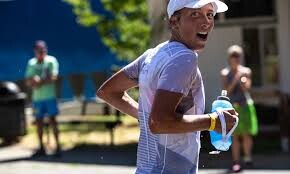
American Zach Miller is on the roster, although he is likely to miss the event due to recent appendix surgery.
The Hardrock 100 begins and ends in the town of Silverton and passes through some of the most spectacular mountain scenery in the United States, home to elk, bears and cougars. The highest point is Handies Peak, at 4,200 meters.
The race will start on Friday 12th July at 6am (2pm in Spain) and can be followed live on YouTube .
by Matias Camenforte
Login to leave a comment
Hardrock 100
100-mile run with 33,050 feet of climb and 33,050 feet of descent for a total elevation change of 66,100 feet with an average elevation of 11,186 feet - low point 7,680 feet (Ouray) and high point 14,048 feet (Handies Peak). The run starts and ends in Silverton, Colorado and travels through the towns of Telluride, Ouray, and the ghost town...
more...Hardrock 100 extends pregnancy deferral for up to five years
While some runners complained the policy is long overdue, most greeted the news with cheers.
The ultra-trail world is applauding Hardrock 100’s progressive, new pregnancy/parental deferral policy, which the race announced on Instagram on Monday. The new policy encompasses both pregnancy and situations involving adoption and surrogacy.
The new policy allows any woman who has been selected to race (or who gets in off the waitlist) who was pregnant on lottery day (Dec. 2, 2023, for the 2024 race), or who becomes pregnant between lottery day and race day (July 12), or who has given birth anytime during the six-month period leading up to lottery day, to defer their entry for five years. It may also be claimed by the partner of women who give birth during the six months leading to race day, or up to two months after race day.
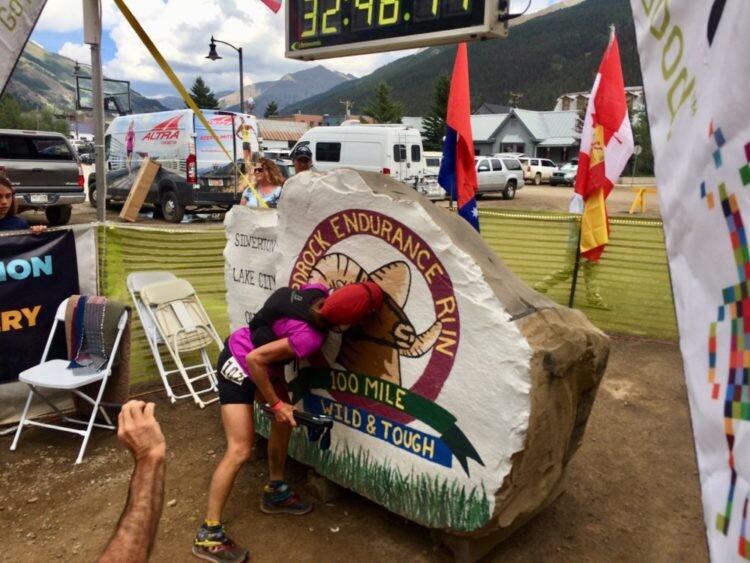
Further, the policy allows surrogate parents whose due date falls within the six-month period leading up to race day to claim a one-year deferral. This policy also applies to parents who adopt a child during the same six-month period (provided the child is under five years old).
“At Hardrock, we firmly believe that runners of all types shouldn’t have to choose between chasing their dreams on the trails and pursuing the option of becoming parents,” the race posted on Instagram. “That is why we have updated our Pregnancy Entry Deferral policy to provide a more generous deferral period for pregnant women and new mothers, and expanded coverage to include other types of new parents, such as in situations of surrogacy and adoption.”
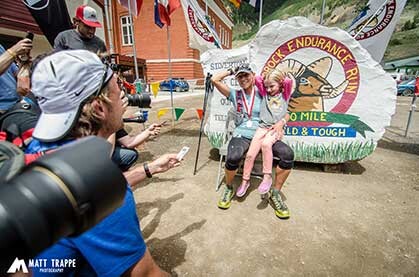
News of the new policy was greeted with mostly positive comments, though some decried the length of time it has taken for the race to finally acknowledge the realities of life for parents and those who are trying to have children. Canadian ultrarunner Stephanie Case (@theultrarunnergirl), who finished second in 2022, is a Hardrock board member and spoke to Canadian Running about her own fertility journey in a feature in the 2024 Trail Special Issue, commented “Proud to be on this board!”
The policy is somewhat less generous than that of the Western States Endurance Run (as an example of a comparable race), in that the eligibility period begins when a runner enters the lottery, and deferral may be for an indefinite period; however WSER’s policy applies only to pregnant women. The policy at Ultra-Trail du Mont Blanc (UTMB), like Hardrock’s, applies to surrogate and adoptive parents and partners of pregnant women, for up to five years (with certain restrictions).
by Anne Francis
Login to leave a comment
Hardrock 100
100-mile run with 33,050 feet of climb and 33,050 feet of descent for a total elevation change of 66,100 feet with an average elevation of 11,186 feet - low point 7,680 feet (Ouray) and high point 14,048 feet (Handies Peak). The run starts and ends in Silverton, Colorado and travels through the towns of Telluride, Ouray, and the ghost town...
more...The Keys to Courtney Dauwalter’s Continued Dominance
Ultrarunner extraordinaire Courtney Dauwalter has picked up in 2024 right where she left off last year. After famously winning three of ultrarunning’s most epic races during the span of about nine weeks last summer—Western States 100, Hardrock 100, and Ultra-Trail du Mont-Blanc—the 39-year-old athlete from Leadville, Colorado, defended her Transgrancanaria 126K title in a decisive wire-to-wire win in late February and won the Mount Fuji 100-miler for the second time on April 27, placing third overall. She’s now gearing up to go for a third straight win at the Hardrock 100 on July 12-13 in Silverton, Colorado. After Hardrock, she’ll be crewing and pacing her husband, Kevin Schmidt, at the Leadville 100 on August 17-18, and then tackling a yet-unannounced trail running project in September.
We caught up with Dauwalter to talk about her fueling and training in a virtual press conference, where she announced the May 20 release of her signature flavor of Tailwind Nutrition Endurance Fuel—Dauwaltermelon with Lime—as a permanent part of the brand’s lineup. Since she’s emerged as one of the world’s top trail ultrarunners, she’s been known for having a sound approach to nutrition and fueling, never shying away from eating whatever she wants, admitting her soft spot for candy and pastries, or having a beer every now and then if she feels like it.
RUN: How did you develop such a sensible approach to nutrition and fueling, and what, if anything, have you changed?
Courtney Dauwalter: “I am still eating all of my favorite things whenever they sound good in quantities that sound good, and I am not intending to change that part of my life, because it just gives me a lot of joy to live that way. I guess it’s got to be partly my upbringing, and also with Kevin and I, our idea of how we want to live our lives is to enjoy it to its fullest while it’s here. We just want to enjoy food, enjoy meals out, enjoy the cravings that we have, and not worry about it. But I would say in the past couple of years I do more consistently do a recovery drink after a long run or after putting in big efforts, and that’s something that I was a little more lax with originally, so I feel like that’s a step in the right direction.”
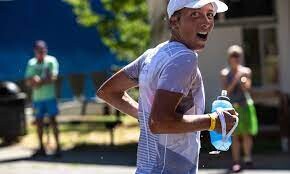
RUN: What was your fueling strategy when you first got into ultrarunning in 2011?
CD: “When I first got into ultrarunning, I had no nutrition plan. I didn’t know what I was doing. My first race was a 50K, and I remember not knowing that these aid stations would be buffets. My mind was blown when I got to them—all the options were overwhelming. I just started filling my pockets with jelly beans. In those first years, I did a lot of mimicking of what the people around me were doing. So if I came to an aid station and someone was grabbing pickles and drinking Mountain Dew, then that’s what I would do. If they were grabbing pretzels and cheese cubes, that’s what I would go for. It was just kind of roulette for me on what I would end up eating—if it would work, or if it wouldn’t work.”
RUN: You have told stories about a few famous bonks early in your career. When did you start to dial-in your fueling strategy?
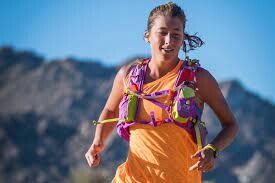
CD: “Initially, I never had a fueling plan at all. But then in 2017, I went to the Run Rabbit Run 100 in Steamboat Springs, Colorado, and Tailwind was available on course at all of the aid stations. I had a buddy who had started using it that year, and I remember just loving it and suddenly not having all the stomach issues and energy dips that I often had. I was like, ‘Oh, maybe this is what it’s like to have something reliable.'”
RUN: What is your current approach to race-day nutrition?
CD: “At this point we’ve gotten pretty dialed on the race nutrition plan for those 10-to 24-hour efforts or the events of 100 miles or below. I’m not a person who has my watch beeping at me ever to remind me to eat. I don’t get those kinds of reminders, and I don’t want to eat every 15 minutes or 30 minutes during a race. I’m going to just slow drip the calories I have as often as possible—basically it’s an eating contest on the move. Now I know my body functions pretty well with about 200 calories per hour during those efforts. So, depending on the distance between aid stations, I can rely solely on a bottle of Tailwind and then supplement with some chews or waffles or gels, because usually I get actually hungry feeling and having something solid helps with that. But mostly, I’m relying on Tailwind as my backbone to the whole plan and generally aiming for that 200-calorie-per-hour benchmark”
RUN: You had to overcome some stomach challenges in UTMB in 2022 and then at last year’s UTMB you seemed as physically challenged as you have ever been. How have you adjusted your fueling in those situations?
CD: “The past couple years (working with a nutritionist friend), we’ve been better at creating A, B, C and D plans—because sometimes the perfect nutrition plan that you have relied on isn’t going to work. Our approach is that’s fine, and here are some things you can start subbing in during a race that can cover your needs. I view race nutrition like a puzzle piece, and sometimes it fits into the puzzle right where we want it to, and sometimes we have to kind shift things around a little bit. I think one of the reasons a lot of us love ultrarunning is because, when things just aren’t going to plan, we have to problem-solve it.”
RUN: You’ll be doing a lot of your pre-Hardrock training in and around Leadville between 11,000 and 14,000 feet above sea level once the spring snow subsides. How are you able to fuel at such high altitudes?
CD: “That’s one thing I’m hoping to focus on a little bit more on in this buildup and this prep for Hardrock, because in the past couple times I’ve run it, I’ve struggled a little bit with taking stuff in. I would love to just try to intentionally train my stomach to be better at taking in those calories while pushing hard at 12,500 feet or 13,000 feet just to see if we can make some strides forward. So stay tuned on if that works or not.”
RUN: Do you have any bucket list events you want to tackle in the coming years?
CD: “Not specific things. I think I want to just keep finding the challenges that intrigue me and fire me up to keep putting in the work, the training, the time, the effort to go after them. And so whatever that is, there’s not a list of things I want to check off necessarily, but, I’m continuing to pour myself into this sport and see what’s possible while every one of my systems [muscular, digestive, endocrine, cognitive, emotional, etc.] is allowing that to happen. The Leadville 100 is on my short list of races I would love to do as soon as I can, but as far as a bucket list in general or what intrigues me, I’m still very interested in exploring the longer stuff and how our brains and our bodies can work together to take us over 100 miles. What does that look like to move efficiently for 200 miles or 500 miles? So that’s where I am putting a lot of my attention into—just finding ways to test myself on stuff that’s really long.”
by Brian Metzler
Login to leave a comment
Hardrock 100
100-mile run with 33,050 feet of climb and 33,050 feet of descent for a total elevation change of 66,100 feet with an average elevation of 11,186 feet - low point 7,680 feet (Ouray) and high point 14,048 feet (Handies Peak). The run starts and ends in Silverton, Colorado and travels through the towns of Telluride, Ouray, and the ghost town...
more...2023 Hardrock 100 Women’s Race
If it wasn’t for Courtney Dauwalter (pre-race interview) running the Western States 100 just three weeks prior, crushing the women’s record there, and potentially being a bit worn out at the start line of the Hardrock 100, it would have been hard to find someone to bet against her winning the race this year. But if she were to falter, there were several women who were ready to jump at the opportunity.
For the first part of the race, it seemed like France’s Anne-Lise Rousset Séguret was going to do just that. While Dauwalter led in the very early miles of the course, Rousset opened up a sizable gap coming through Maggie Gulch at mile 15.5 and was moving with enthusiasm toward Pole Creek, the next aid station. She came into Sherman at mile 30 in seventh overall in 6:29, looking strong. Dauwalter was just six minutes behind, and Annie Hughes (pre-race interview) came in next, 52 minutes off the lead. With still many miles to run, it was still anyone’s race. Frenchwoman Claire Bannwarth (pre-race interview) came through just seven minutes later and was followed by Japan’s Kimino Miyazaki (pre-race interview), who was 1:22 off the lead but looking spry and happy.
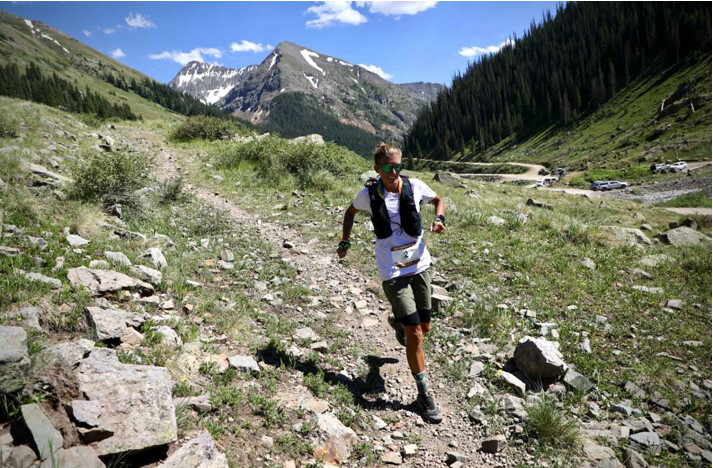

The top-two women came back together through Grizzly Gulch at mile 36 with Hughes trailing them at just under an hour back. When Rousset led Dauwalter into Grouse Gulch, mile 43.5, by nearly 10 minutes after traversing Handies Peak, the course high point, it seemed like maybe the Western States 100-Hardrock 100 double was going to be too much for Dauwalter to handle.
But it’s never a good idea to bet against the most dominant female trail ultrarunner of this generation. By mile 50, she’d closed the gap to four minutes, and in Ouray at mile 58.5, it was down to two minutes. When it came to the climb out of Ouray, Dauwalter made her move, and the elastic to Rousset finally snapped over the top of Virginius Pass. Dauwalter never looked back.
Meanwhile, Hughes stayed steady in third place while dealing with stomach issues and the rest of the women’s pack, including Miyazaki, Bannwarth, Christina Bauer, Whitney Mickelsen, Darla Askew, Becky Bates, and last-minute waitlist entrant Emily Halnon, who only got into the race the morning before, continued to chase — all within close proximity to each other.
Dauwalter ran into Telluride at mile 74.5, her pace still hovering just a few minutes over course-record pace, but now 23 minutes ahead of second-place Rousset, and executed the fasted crew stop of the Telluride aid station, getting in and out in under three minutes. She was on a mission.
Just 10 miles later, she was well below course-record pace, crushing the Bear Creek Trail climb out of Telluride and moving herself into third overall as some of the lead men began to falter. Rousset also continued her relentless march, and while she was 48 minutes back on Dauwalter at mile 84, she was only three minutes up on course-record pace.
In the end, there was no catching Dauwalter as she ran back to Silverton to kiss the rock with a new women’s counterclockwise course record of 26:14:08, besting the one set by the legendary Diana Finkel in 2009, and finishing fourth overall. She also set a new overall women’s record, beating her old time of 26:44:36, which she set last year.
Not only that, she set a new overall record for the Western States 100-Hardrock 100 double with a combined time of 41:43:42, beating Jeff Browning’s old record of 42:12:43 that he set in 2016.
Rousset would finish second after a gutsy run with a time of 27:29:55, which registers as the fifth-fastest time in event history, and Hughes would hold onto third with a time of 32:13:03 after spending nearly 100 miles battling stomach and breathing issues.With large gaps between the first, second, and third women, all eyes turned to the competition between fourth and 10th where the time gaps were tight and the women were often in the aid stations together in the back half of the race. Miyazaki and Bannwarth ran in close proximity to each other battling for fourth and fifth, while Mickelsen, Halnon, Bates, Askew, and Bauer seemed to maintain the same overall pace as the miles ticked by.
by Eszter Horanyi -I run far
Login to leave a comment
Hardrock 100
100-mile run with 33,050 feet of climb and 33,050 feet of descent for a total elevation change of 66,100 feet with an average elevation of 11,186 feet - low point 7,680 feet (Ouray) and high point 14,048 feet (Handies Peak). The run starts and ends in Silverton, Colorado and travels through the towns of Telluride, Ouray, and the ghost town...
more...2023 Hardrock 100 Men’s Race
Without any clear race favorite this year, the men’s race was wide open, and France’s Aurélien Dunand-Pallaz (pre-race interview) made the most of the opportunity to go to the front immediately, leading the race line-to-line. Even before the first mile was up, Dunand-Pallaz had opened up a gap on the rest of the field and never looked back, running steady and strong through the heat of the day and the dark of the night.
Behind Dunand-Pallaz, the race between the rest of the field never let up, but the gap to the leader continued to grow steadily as the hours passed. Silverton local Avery Collins (pre-race interview)led the early chase, along with Dylan Bowman (pre-race interview), who had finished second here in 2021. While Dunand-Pallaz was running his first Hardrock 100, Bowman had course experience on his side, and Collins had the course in his backyard to train on.Behind the two Americans, another Frenchman, Beñat Marmissolle (pre-race interview), was biding his time in third. Brian Culmo, Spaniard Javi Dominguez, Arlen Glick, former Hardrock 100 champion Jeff Browning, Paul Terranova, and Jesse Haynes rounded out the top 10 in the early miles of the race.Coming through the Maggie aid station at mile 15.5, it seemed like Dunand-Pallaz was going to give the men’s record a run for its money, coming in about 10 minutes under course-record pace. By this time, he was also 10 minutes up on Collins, who was running in second. While Dunand-Pallaz’s gap on the course record had disappeared by the time he dropped into the Sherman aid station at mile 30, his gap on the rest of the field had grown to 13 minutes, now with Marmissolle running in second with Bowman and Collins just a couple of minutes back. The rest of the top 10 remained unchanged.And aside from a few shuffles within the field, not a whole lot changed in the top 10 until the witching hours, after the heat of the day turned to the dark of night and legs started to get heavy. Then things started to change, and quickly. While the two Frenchmen continued their relentless march forward, both Collins and Bowman faltered, and it was Dominguez who left the Chapman aid station at mile 84 in third. Glick was fourth, Terranova fifth, and Browning sixth. Both Collins and Bowman took extended stops at Chapman to regroup, losing their positions but eventually headed back out on the trail to finish.While others struggled behind him, Dunand-Pallaz crested the last climb well clear of the field. Marmissolle followed 40 minutes back. And from there, it was almost all downhill for the two Frenchmen. Dunand-Pallaz ran back into Silverton to kiss the rock and win his first Hardrock 100 in 23:00:07, the eighth-fastest time in history.
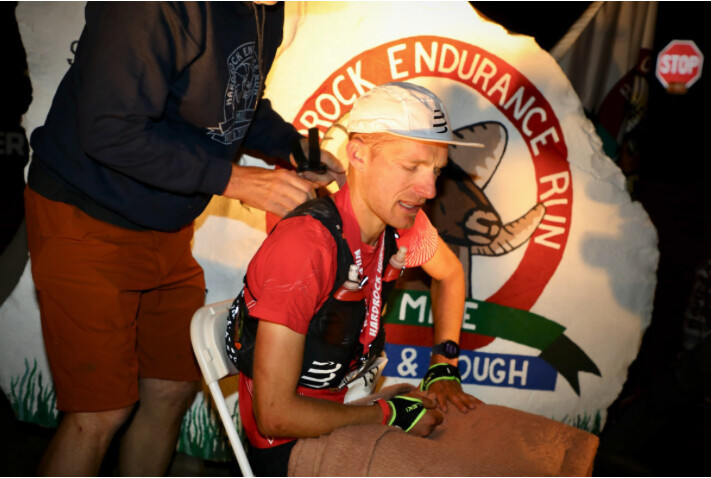
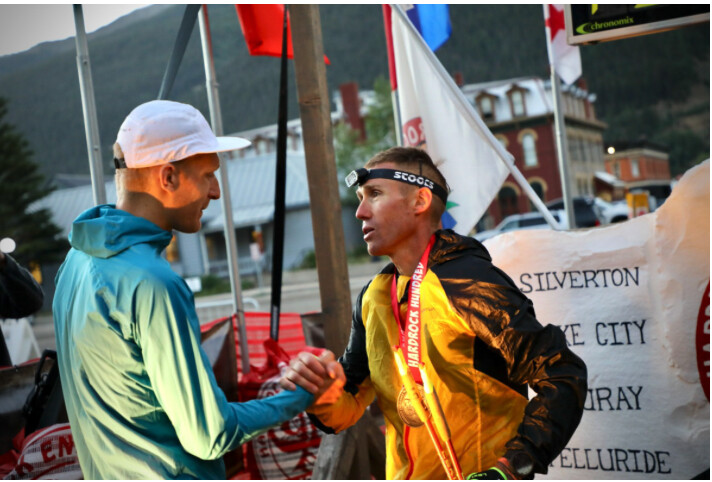
Marmissolle finished second and was followed by Dominguez who ran a steady and smart race from start to end finished third in 26:12:01. Glick finished fourth with a time of 26:43:05, and Browning would round out the top five with a time of 27:17:02.
by Eszter Horanyi -I Run Far
Login to leave a comment
Hardrock 100
100-mile run with 33,050 feet of climb and 33,050 feet of descent for a total elevation change of 66,100 feet with an average elevation of 11,186 feet - low point 7,680 feet (Ouray) and high point 14,048 feet (Handies Peak). The run starts and ends in Silverton, Colorado and travels through the towns of Telluride, Ouray, and the ghost town...
more...Hardrock 100 preview: will Courtney Dauwalter do it again?
The Hardrock Hundred Mile Endurance Run (HR100), known for its high altitude, deep elite field and challenging entry process, begins Friday at 8:00 a.m. E.T. This year’s event, the first ever to be live-streamed, promises to be a thriller. Runners will encounter over 10,000 metres of elevation gain while facing extreme weather conditions, navigating treacherous terrain and attempting to avoid altitude sickness.
Only 140 participants get to line up at Hardrock each year, and this year’s contenders include the remarkable Courtney Dauwalter, fresh off a jaw-dropping performance and course record at the Western States 100, and other well-known elites. The race will be live-streamed on the Run Steep Get High YouTube channel. Here’s what you need to know to follow along.
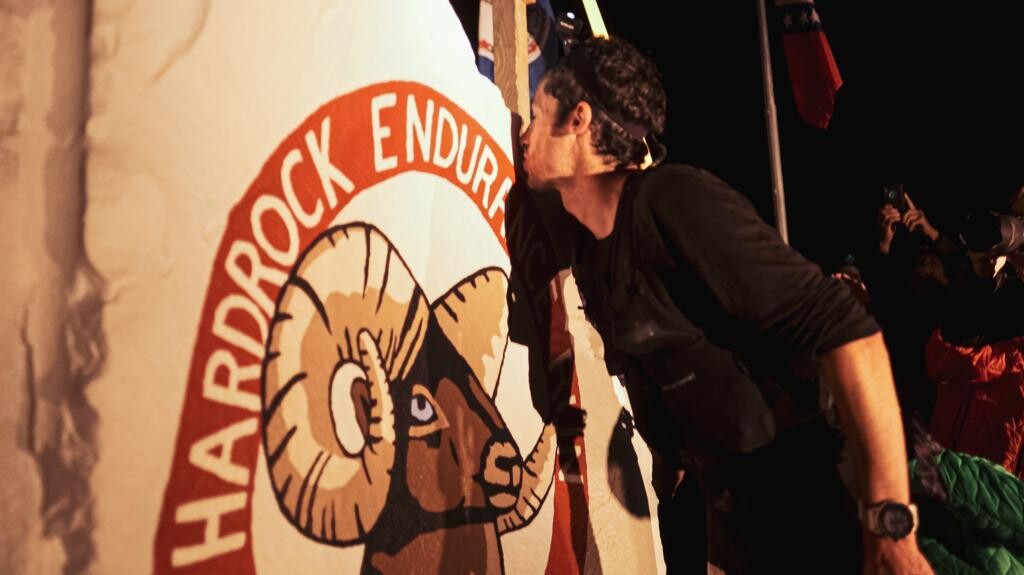
HR100 both begins and ends in Silverton, Co., and athletes are above 3,300 metres elevation for much of the race. It was founded in 1992 as a tribute to the miners who used to follow “their mules and instincts, prospecting the San Juans for gold, silver, and other metals,” the race website explains. With a finishing cutoff time of 48 hours, athletes know they are in for a long haul. The course switches directions every year, and this year runners are moving counter-clockwise around the looped course.
The women’s race

All eyes are on the phenomenal Dauwalter this year (but when are they not?) after a stunning performance three weeks ago at Western States, where she set a blistering new course record (78 minutes faster than Canadian Ellie Greenwood’s from 2012) and placed fifth overall. Canada’s Stephanie Case, who was second last year, has withdrawn from this year’s event. 60-year-old legendary ultra machine Pam Reed of Jackson Hole, Wyo., will be tackling the third part of her WSER/Badwater 135/HR100 triple this year.
Leadville, Colo.-based Dauwalter holds the course record for HR100 in the clockwise direction (26:44) from 2022; this year runners will move counter-clockwise, and that course record is 27:18 for women, set by Diana Finkel in 2009, and Dauwalter will most certainly be looking to challenge that time. Will her legs be tired? Will she win the entire thing? We can’t wait to find out.
Also from Leadville, 23-year-old trail phenom Annie Hughes won the Run Rabbit Run 100-Miler and High Lonesome 100 Mile in 2022, and the Leadville 100 Mile in 2021. She’s a high-altitude ultrarunning champ, and has also compiled some wins in really long races–she won the Cocodona 250 Mile in 2022 and Moab 240 in 2021.
If you haven’t heard of France’s Claire Bannwarth, it’s time to brush up: she was the first woman in the 432-kilometre 2022 Winter Spine Race (by more than 24 hours), and will be making her North American racing debut at HR100. Bannwarth races prolifically and runs long–she will be jumping into the Tahoe 200 Mile race a week after HR100.
Colorado’s Darcy Piceu, fresh off the waitlist, is a veteran of HR 100, with the 2023 edition being her 10th running. Piceu boasts three wins and five second-place finishes, and she was fourth in 2022.
The men’s race
With Kilian Jornet, last year’s winner (and course record holder in the clockwise direction) not returning this year, the podium seems up for grabs. None of the other top four men from 2022 will be headed to the San Juans, but a very accomplished group of athletes will be lining up and fans will be eager to see who holds up to the HR100 test.
Ohio’s Arlen Glick is a master of the 100-mile distance, running 12:57 to win the Umstead 100-miler in April and taking a speedy third at October’s Javelina 100. Like Dauwalter, Glick raced at WSER last month. He placed 14th, while he took third in 2022. Glick will be a hot contender and fascinating to watch at HR100.
California-based Dylan Bowman is a Hardrock veteran, placing second at the 2021 edition. Bowman has had a lower racing profile in the past year while working on Freetrail, a media business and trail running community. He’s been training in the San Juans pre-race and is eager to showcase his ability.
France’s Aurélien Dunand-Pallaz has over 10 years of ultrarunning success, but gained notoriety in 2021 when he took second at UTMB and won Spain’s Transgrancanaria. He missed the 2022 edition of HR100 for the birth of his child and is a favourite in his debut this year.
Oregon-based trail running legend Jeff Browning will be taking on his sixth Hardrock at age 51. Browning won in 2018, and finished fifth the past two years. In October, Browning won the Moab 240 in 57 hours, and more recently, he showcased his fitness by winning the Bighorn 100.
by Keeley Milne
Login to leave a comment
Hardrock 100
100-mile run with 33,050 feet of climb and 33,050 feet of descent for a total elevation change of 66,100 feet with an average elevation of 11,186 feet - low point 7,680 feet (Ouray) and high point 14,048 feet (Handies Peak). The run starts and ends in Silverton, Colorado and travels through the towns of Telluride, Ouray, and the ghost town...
more...Five wins, a dislocated shoulder and the course record – Kilian Jornet at Hardrock 100
Kilian Jornet has dominated several races throughout his career and Hardrock 100 is one of the many where he has left a significant impression.
The Spaniard, widely regarded as mountain running’s GOAT (Greatest Of All Time), has triumphed five times at the iconic 102.5-mile race in the San Juan Mountains in Colorado, USA.
Jornet is the joint-most successful runner in Hardrock 100 history – which dates back to 1992 – alongside Karl Meltzer and Betsy Kalmeyer. He has won the race each time he has entered, with his first triumph coming in 2014.
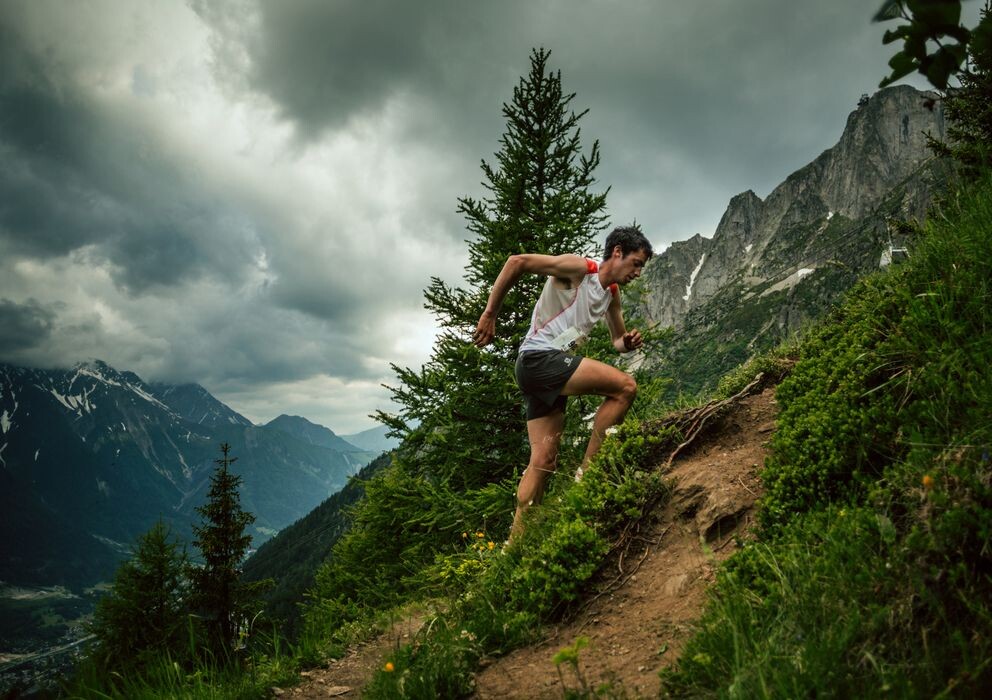
Four-time Ultra-Trail du Mont-Blanc (UTMB) winner Jornet also holds the course record at Hardrock 100, completing the clockwise route in 21:36:24 last year.
Having been raised in the Spanish Pyrenees, Jornet has thrived at high-altitude races, and that ability has been apparent at Hardrock 100, which features a total elevation gain of 33,195ft and boasts a highest point of 4,048ft.
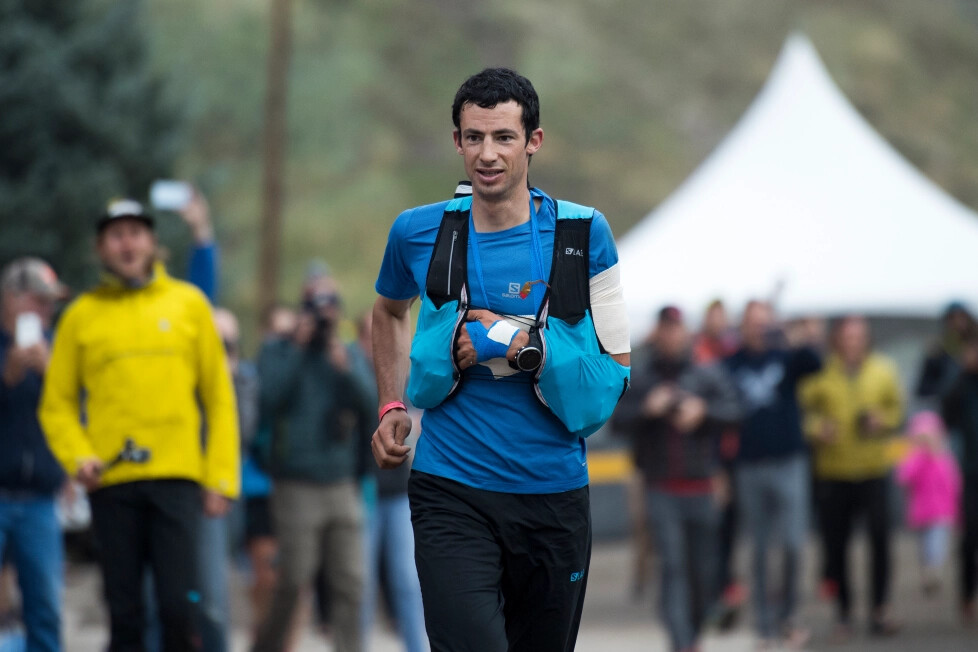
Instant impact
Jornet debuted at Hardrock 100 almost a decade ago, coming into the race off the back of wins at Zegama-Aizkorri and Marathon du Mont-Blanc in the two months prior.
He would lay down an instant marker as he romped to victory in a clockwise-record time of 22:41:00, finishing nearly two and a half hours clear of France’s Julien Chorier, the 2011 winner.
It was the first time a runner had managed sub-23 hours at Hardrock 100, with USA’s Kyle Skaggs having recorded the previous best of 23:23:10 in 2008.
The next year, Jornet claimed victory again – this time more than two hours ahead of USA’s Mike Foote – eclipsing the counter-clockwise course record on that occasion. He clocked 23:28:00, shaving just under an hour off Frenchman Sebastien Chaigneau’s 2013 effort.
He made it three in a row in 2016, sharing the title with Jason Schlarb after an incredible duel with the American. Having worked together and battled for hours, the pair agreed to finish together, coming home in 22:58:28.
Dislocated shoulder
2017 would bring a fourth successive Hardrock 100 victory for Jornet, but it was far from straightforward as he took a fall and suffered a dislocated shoulder around 14 miles into the race.
He powered on regardless, popping his joint back into place before medics wrapped his damaged limb in a sling later on in the day.
Incredibly, despite being forced to use a single trekking pole and facing a vicious hail storm, Jornet clinched the win again as he finished in 24:32:20, 23 minutes clear of Foote.
Record obliterated
Jornet didn’t race at Hardrock 100 for five years after his four back-to-back victories, and France’s Francois D’Haene beat both his overall and counterclockwise records when he put up a staggering 21:45:50 in 2021.
But a sensational return came last year as Jornet improved the record further, finishing in 21:36:24 and overcoming second-place D’Haene by around 15 minutes.
Weird and wonderful
Jornet has often spoken of his affection for Hardrock 100, hailing its remarkable setting and quirky traditions, a trait shared with some of the world’s craziest ultramarathons.
To complete the event, runners are required to ‘kiss the Hardrock’, a picture of a ram’s head painted on a large block of stone mining debris – a nod to the origins of the race.
“Leaving a rock with a mountain goat painted on it, to run around the San Juan mountains with a bunch of other runners, aiming to get back to that rock to give it a kiss,” Jornet wrote in an Instagram post.
“Ultra running can be as weird as beautiful and I love it!”
The Rocky Mountains provide a stunning landscape for Hardrock 100, and Jornet, who is dedicated to environmental sustainability, has spoken of his affection for the area and the people who make the race possible.
“The wilderness and landscapes of San Juan Mountains are so breathtaking,” he added in another post. “I feel so fortunate to know this part of the world.
“The race is attractive because of its beautiful landscapes and the hardness of the challenge – high elevation, several times above 4,000m, the route often on steep narrow trails.
“What makes one want to come back it’s its community. The volunteers, the crewing and pacers, the people doing trail work, and the runners celebrating together the love for trail running and this mountains.”
by Olly Green
Login to leave a comment
Hardrock 100
100-mile run with 33,050 feet of climb and 33,050 feet of descent for a total elevation change of 66,100 feet with an average elevation of 11,186 feet - low point 7,680 feet (Ouray) and high point 14,048 feet (Handies Peak). The run starts and ends in Silverton, Colorado and travels through the towns of Telluride, Ouray, and the ghost town...
more...2022 Hardrock 100 Women’s Race
The 2022 Hardrock 100 start list included 27 women, the most the race has ever had. As anticipated, Courtney Dauwalter (pre-race interview) scored a decisive victory, setting a new clockwise and overall women’s course record. Diana Finkel previously held the clockwise record of 28:32 (2010) and overall record of 27:18:24 (2009). Further back in the field, the top ten of the field was much more closely packed this year than we’ve seen previously at Hardrock, including last year’s second- and third-place finishers Darcy Piceu (pre-race interview) and Meghan Hicks, late entrant off the waitlist Hannah Green, and 450k Tor des Glaciers winner Stephanie Case (pre-race interview). Here’s how the race unfolded.
Dauwalter was off to an early lead, but started conservatively enough without trying to gap the course record pace immediately. She got through the Chapman aid station at mile 18 with 4:16 on the clock. Darcy Piceu and Maggie Guterl (pre-race interview) followed in second and third, some 37 minutes back, in jovial humor, waiting for each other at the aid station. They were followed 10 minutes later by Hannah Green in fourth, with Stephanie Case another two minutes back in fifth.
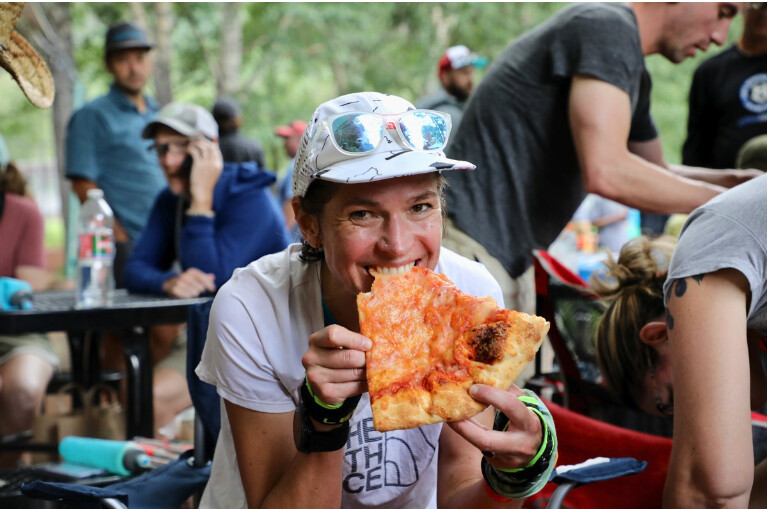

Through Telluride at mile 28, Dauwalter had extended her lead on second place, Guterl, to 67 minutes, with Piceu coming in a close third and leaving the aid station alongside Guterl. Hannah Green followed in fourth, with Stephanie Case in fifth, who was already recovering from some early stomach issues.
Past mile 33 at Kroger’s Canteen, as Dauwalter barreled ahead, the chasing women had paired off and were working together — with Piceu and Guterl still in second and third and all smiles, while Hannah Green and Stephanie Case had joined forces 22 minutes back from that duo.
Dauwalter arrived at the Engineer aid station, just past the halfway point, in sixth-place overall with 12:10 on the clock, still looking strong and in control. The effort was starting to show by Sherman at mile 73, but she was still eating well and focused.
Stephanie Case, who had crept up the women’s field, arrived into Sherman as second woman. Hannah Green followed in third at mile 73 — looking tired, but calm and collected as she had done all race — with Darcy Piceu and Meghan Hicks nipping at her heels in fourth and fifth.
By this point, Duawalter was more than five hours clear of her nearest women’s competitor, and thoughts were starting to turn to Diana Finkel’s longstanding course records. After a relatively conservative beginning, Dauwalter finally took the lid off of course record pace by mile 93 at Cunningham Gulch, coming in with 24:16 on the clock. She seemed to grow in strength and resolve as the finish line approached, and eventually stormed home in a time of 26:44:38, to add Hardrock 100 to her litany of wins, course records, and other ultrarunning achievements.Case ran strong to the ending, finish her first Hardrock 100 in second place in 32:52:46. The town of Silverton came out to celebrate local resident Hannah Green’s third-place finish in a time of 34:26:39, taking nearly two full hours offer her time from 2017.For the first time in her nine starts, Darcy Picue finished lower than second, but she worked through endless to finish fourth in 35:08:06.
by Bryon Powell and Sarah Brady I run far
Login to leave a comment
Hardrock 100
100-mile run with 33,050 feet of climb and 33,050 feet of descent for a total elevation change of 66,100 feet with an average elevation of 11,186 feet - low point 7,680 feet (Ouray) and high point 14,048 feet (Handies Peak). The run starts and ends in Silverton, Colorado and travels through the towns of Telluride, Ouray, and the ghost town...
more...2022 Hardrock 100 Men’s Race
The men’s race at the 2022 Hardrock 100 finished pretty much in line with expectations – with an epic showdown between two of the greatest talents ever seen in the sport – Kilian Jornet (pre-race interview) and François D’Haene (pre-race interview). But there was plenty more action along the way, with bold moves from Dakota Jones (pre-race interview), and some strong running further back the field. Here’s how this year’s clockwise action played out.
From the start, the runners made a fairly predictable formation at the front of the field. Dakota Jones, Francois D’Haene, and Kilian Jornet led the charge, running together, with Jones joking with one of our reporters that they had agreed to finish in the aforementioned order. A very happy looking Dani Jung followed close back from the leaders in fourth at the KT aid station at mile 11.5, with John Kelly three minutes later in fifth. There was a gap of ten minutes or more from this front pack to Jeff Browning and Luke Nelson, who looked to be taking it very easy in sixth and seventh.The front trio remained within a few strides of each other the whole way into Ouray at mile 44, and although looking relaxed, they were already twelve minutes up on course record pace. Jung still followed in fourth, but the gap had widened to almost half an hour. He still looked very fresh and appeared to be taking the high road and running his own race, rather than getting caught up in anything outside of his comfort zone. The next three positions — Kelly, Browning, and Nelson — also remained unchanged with Kelly appearing more sombre than the others, but still making a fast turnaround in the aid station.
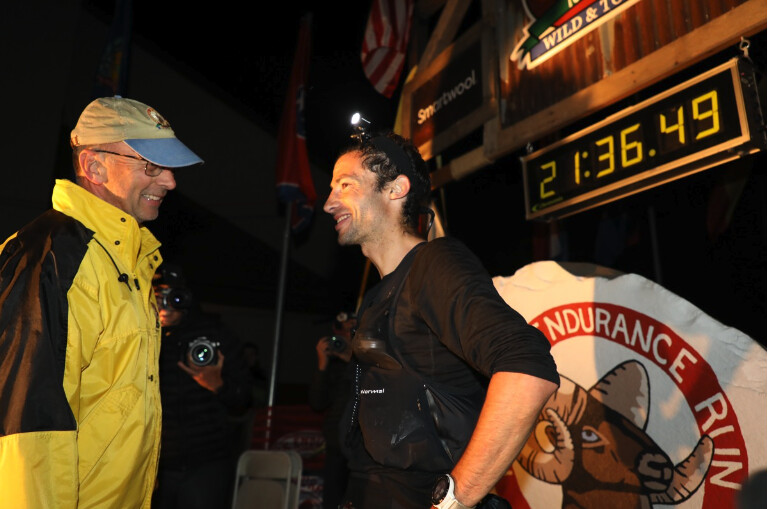
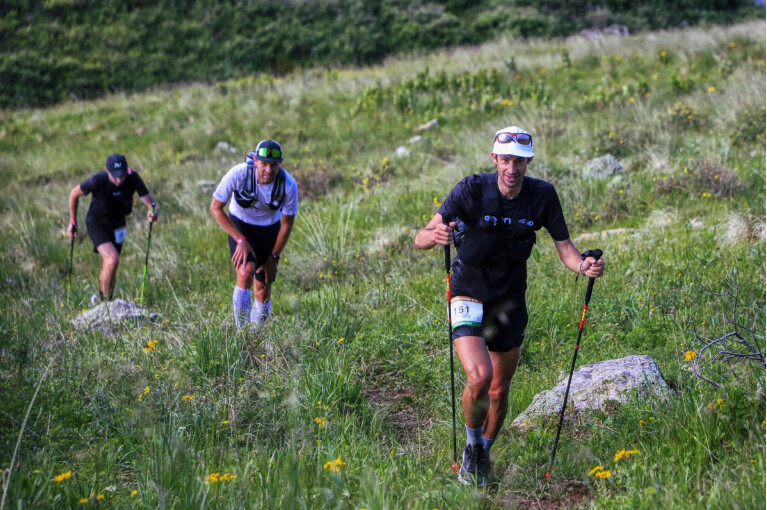
Jones was the one to make the move that cracked the front trio, and he came into the Engineer aid station at roughly the halfway point 11 minutes clear of Jornet and D’Haene, who remained together. Jung held on steadfastly in fourth, and former Hardrock champion Browning had moved up to take fifth from a struggling John Kelly.Jones continued to lead the way through Grizzly Gulch, two-thirds of the way into the race, but the Euro duo of Jornet and D’Haene had begun to close. By Sherman at mile 73, the two had joined forces, entering and leaving the aid station together eight minutes ahead of Jones.
They continued to run within seconds of each other, but by Cunningham Gulch at mile 93, there was a notable shift in tone as the race had begun in earnest. Jornet was the first to leave the aid station with D’Haene following seconds later. D’Haene looked strong and can never be underestimated in the finish, but after the headtorches began to flicker on the final descent through Arrastra Gulch, it was Jornet who emerged first from the darkness, having put five minutes on his friend and opponent in the roughly four-mile stretch.
Jornet powered through to the finish, taking his fifth victory in five Hardrock starts, and a clockwise and overall course record in a time of 21:36:34. D’Haene followed and touched the rock at 21:51:21, which was also under the original clockwise record from Jornet’s 2014 run.Further back, despite losing hold of first place, Dakota Jones never stopped pushing and took third in a strong 23:06:19, making his pre-race goal of breaking 24 hours.
An emotional Dani Jung came home in fourth, a position he held essentially all race, in a time of 25:53:47. This is just the beginning of Jung’s season, with UTMB and Diagonale des Fous still to come, and it will be interesting to watch him build on this performance.Jeff Browning was next home, finishing his sixth Hardrock in a time of 26:17:47, saying at the finish “It doesn’t get any easier.”
by Bryon Powell and Sarah Brady I run far
Login to leave a comment
Hardrock 100
100-mile run with 33,050 feet of climb and 33,050 feet of descent for a total elevation change of 66,100 feet with an average elevation of 11,186 feet - low point 7,680 feet (Ouray) and high point 14,048 feet (Handies Peak). The run starts and ends in Silverton, Colorado and travels through the towns of Telluride, Ouray, and the ghost town...
more...Strong field will be competing in 2022 Hardrock 100, with a lottery narrows field to 145
The Hardrock 100 ultramarathon held its lottery on Saturday to select runners to fill out its field of 145.
The race had 1,916 runners apply from 46 states and 50 foreign countries this year, which is slightly down from the roughly 2,200 applicants in 2019. The ages of the applicants ranged from 19 to 73, and the largest group was 40 to 49 years old, or 43% of the total.
New this year is a gender-equity provision, guaranteeing the percentage of women in the field at least equals the percentage of women who applied. So, since 345 women applied, representing 18% , 27 women were selected to participate.

“I thought the gender equity worked out well,” said race director Dale Garland. “The lottery is designed for gender equity and also to make it accessible to new runners and people who have been here before. Both are important.”
Because of COVID-19, international runners who were chosen for the previous year’s event but were unable to travel in 2021 gained an automatic entry for the 2022 race, which includes 16 men and two women.
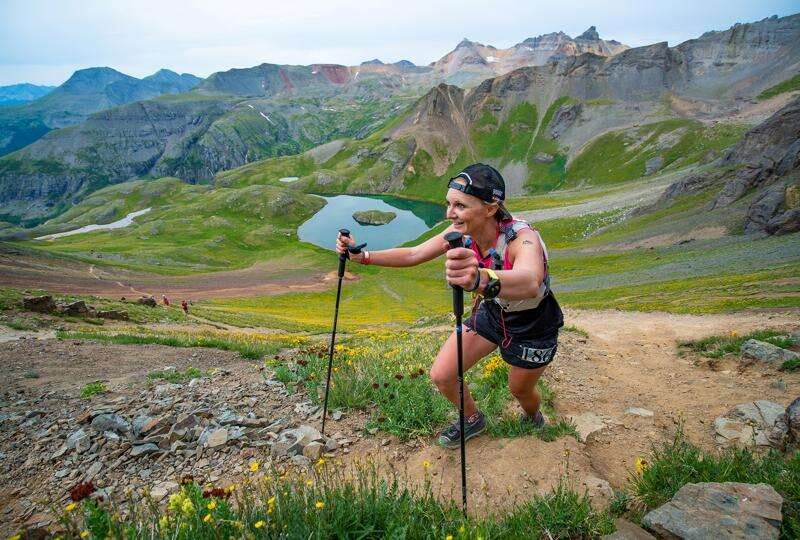
Automatic entry goes to last year’s winners – Sabrina Stanley, a two-time champ, and Francois D’Haene, who set a course record last year. D’Haene also won the Ultra Trail du Mont Blanc last year in Chamonix, France.
Garland also got to choose six entries, which are kept secret. He said, however, that his picks this year are elite runners, some runners who have provided service for the event and two with good storylines.
After that, 119 runners were selected in the lottery. To be eligible for the lottery, the athletes had to complete one of 30 qualifiers around the world that are all at least 100 miles long.
“I’m really happy with it,” Garland said this year’s field of athletes. “There’s some interesting competitive story lines, some competitive longevity story lines, and we’re seeing some people who have run in 10 or 15 Hardrocks.
Killian Jornet, a four-time Hardrock champion, will race again this year. Aurélien Dunand-Pallaz, who finished second at the Ultra-Trail du Mont-Blanc last year, also is expected to compete for the title.
In the women’s race, Courtney Dauwalter, an Ultra Trail du Mont Blanc winner in 2019 and 2021, will challenge Stanley. “It will be an interesting dynamic to have those two run,” Garland said.
Darcy Piceu, an eight-time Hardrock finisher with three wins, also will be in contention, as will Meghan Hicks, a top-three finisher from last year who lives in Silverton, like Stanley.
Neal Matosky of Durango and Durango High School graduate Dakota Jones also will compete.
“I wouldn’t be surprised to see (Jones) in the top 10,” Garland said.
The race takes place July 15-17. It will start at 6 a.m. on July 15, and the runners will have 48 hours to complete the race. It will start at Silverton and go to Telluride first this year, then Ouray, close to Lake City and finish in Silverton. The first race was held in 1992 and this will be the 27th running of the event. Snow and fires caused a few to be canceled.
Volunteers are needed for the event. For information, visit hardrock100.com.
by Cody Olivas
Login to leave a comment
Hardrock 100
100-mile run with 33,050 feet of climb and 33,050 feet of descent for a total elevation change of 66,100 feet with an average elevation of 11,186 feet - low point 7,680 feet (Ouray) and high point 14,048 feet (Handies Peak). The run starts and ends in Silverton, Colorado and travels through the towns of Telluride, Ouray, and the ghost town...
more...Hardrock 100 canceled for second time in as many years
Avalanche debris in 2019, COVID-19 in 2020 wipe out famed ultra-marathon
The Hardrock Hundred Endurance Run can’t catch a break.
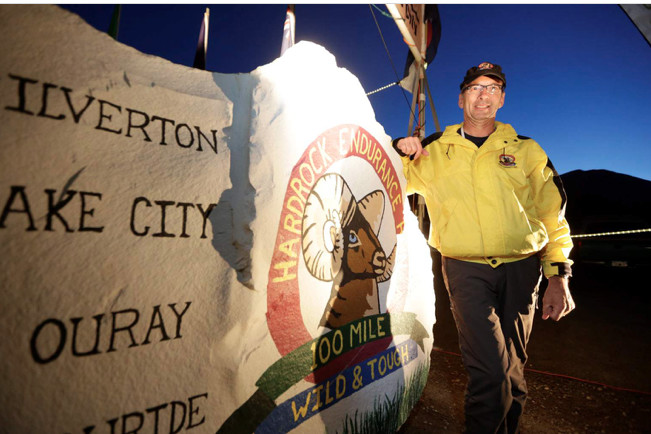
After unveiling a loaded field of U.S. and international runners selected through the lottery in December 2018, the Hardrock 100 ultra-marathon that starts and finishes in Silverton was canceled in 2019 after a winter of heavy snow left avalanche debris and dangerous high water along its 100.5-mile loop through the heart of the southern San Juan Mountains.
A year later with the same field of registered runners as 2019 set to compete, the Hardrock 100 board of directors once again had to cancel one of the world’s most iconic mountain ultra-marathons. This time, it is because of the global COVID-19 pandemic with public health orders in place prohibiting large gatherings such as the Hardrock, which has a field of 145 runners. Though it is a small field of athletes, hundreds more are involved in the form of pacers, crew members, media and run volunteers.
The Hardrock 100 continued to delay its decision until Saturday while similar events in the U.S., such as the Western States Endurance Run in California, canceled much earlier. Western States 100 made its decision March 27.
“This is a tough decision,” said Hardrock 100 director and co-founder Dale Garland in a phone interview with The Durango Herald. “I hated making it. It is not one where just sat down one day and decided to pull the plug. We realize we have an impact on the sport and the economics of the area, and it’s something done with a lot of consideration. I’m really sad, and I have heartache about it.”
The latest Hardrock 100 cancellation is another blow to Silverton, which suffered economically from the affects of less tourism because of the 416 Fire near Durango in 2018. Already in 2020, Silverton has seen the Iron Horse Bicycle Classic, which brings more than 3,000 people to Silverton on Memorial Day weekend, canceled because of COVID-19. Many businesses in Silverton remain closed with only essential visitors allowed into the small mountain town of fewer than 700 residents. In 2019, DeAnna Gallegos, the director of the Silverton Area Chamber of Commerce, said the Hardrock 100 helped deliver $1 million to the local economy.
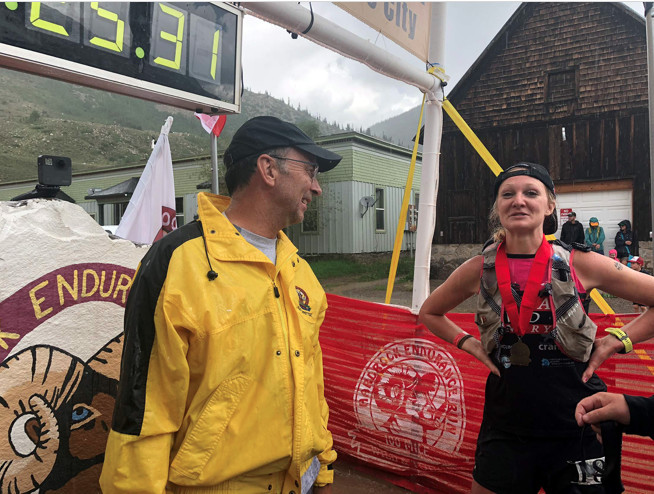
Past experience pays off
The cancellation is the fourth in Hardrock 100 history dating back to 1992. The previous cancellations were all because of natural causes. Along with the dense avalanche debris scattered across the course in 2019, the event was called off in 1995 because of too much snow and in 2002 because of extreme fire danger in the San Juan National Forest.
It was because of that first cancellation in 1995 that Hardrock is able to financially survive a cancellation, even with two in a row. After 1995, the board of directors established a reserve bank account to set aside funds in the case of another lost year.
“We just needed to make a decision by June 1, if we could,” Garland said. “Part of that is to honor people’s flight plans, vacation rentals and all those things. Also, we felt if we made a decision by June 1 we could still buy everything we needed. We hadn’t spent a whole lot of money with equipment, merchandise, awards or anything like that. So, we’re in pretty good shape and didn’t have to hit the reserve account very hard.”
A loaded field awaits fate
The run, which traverses across the rugged San Juan Mountains with 66,050 feet of elevation change at an average elevation of more than 11,000 feet, including the 14,048-foot summit of Handies Peak outside Lake City and seven mountain passes at higher than 13,000 feet, has become a legend among the world’s best ultra runners. Athletes must complete previous qualifying 100-mile races to even enter the lottery, which had a record 2,487 applicants for the 2019 race.
While U.S. stars such as Courtney Dauwalter, Dylan Bowman, Jeff Browning, Jason Schlarb, Sabrina Stanley, Darcy Piceu and Darla Askew were among those expected to run in 2019 and then in 2020, French stars Francois D’Haene and Xavier Thévenard were also highly-anticipated competitors who had gained a lottery spot.
It was expected to be the most talented field in the history of the event, and it has now been put on hold twice.
No announcement was immediately made regarding registration for the 2021 race and if it would once again carry over from the 2019 lottery or if there would be a new lottery.
“It’s up in the air,” Garland said. “That is a board decision, and it’s split. That’s why it hasn’t been decided yet. It’s been two years, so do we keep rolling people over or give 145 new people a shot at it? They’ve been waiting two years for a new lottery, as well. It’s a philosophical difference not resolved yet. We will keep people updated as soon as those decisions are made.”
Garland said making the event larger to accommodate the addition of new runners to the existing pool of 145 already selected would require discussions with the Bureau of Land Management and forest service, as that would exceed what the event’s permit is allowed. He did not indicate that there was a plan to try to increase the size of the event.
Alternative formats didn’t fit Hardrock’s image
Garland and the run committee considered alternative plans to the traditional Hardrock 100 this year. Some suggested it be conducted virtually. There was discussion of holding the event as usual but with staggered starts and without gatherings such as Camp Hardrock, the pre-race briefing and the awards banquet which would have brought all the runners together at the same time.
“I don’t think you can replicate the Hardrock experience virtually,” Garland said. “We entertained the idea, but no, we couldn’t do that. Then we looked to see if we could do it without all the experiences that make Hardrock what it is and build our community. At some point it was like, ‘What are we trying to create?’ Especially for a first time runner, we didn’t want that to be their experience.
“We also thought about doing a regional Hardrock and limiting it to the Four Corners states. But we couldn’t come to a philosophical agreement that we wanted to do something like that, either.”
While Garland said canceling the event stings, he is confident it can move forward and remain a special event. In a year in which the Ultra Trail du Mont Blanc in France and other U.S. events such as Western States and the Leadville 100 have been canceled, he believes the running community will understand.
“What does it say when we can’t do it two years in a row?” Garland said. “That’s why we wanted to wait and see as it got really close if things were going to change or not or if we could make it work. We kept trying to move forward, but we couldn’t do it.”
Login to leave a comment
Hardrock 100
100-mile run with 33,050 feet of climb and 33,050 feet of descent for a total elevation change of 66,100 feet with an average elevation of 11,186 feet - low point 7,680 feet (Ouray) and high point 14,048 feet (Handies Peak). The run starts and ends in Silverton, Colorado and travels through the towns of Telluride, Ouray, and the ghost town...
more...Cancellation of 2019 Hardrock 100 because the trail is not in good shape because of heavy snow during the winter doesn’t deter ultra community
There may not be a 2019 running of the Hardrock Hundred Endurance Run through the San Juan Mountains, but there will be plenty of trail running events that will provide ultra-running enthusiasts a chance to interact with some of the world’s best athletes.
A week of activities kicked off Sunday in Durango, as running stars Anna Frost, François D’haene, Dakota Jones and Hardrock 100 director Dale Garland will gather at the Durango Outdoor Exchange for a public meet and greet and run.
“I think everyone loves talking about Hardrock and running,” said Frost, a two-time Hardrock 100 champion originally from New Zealand who now also calls Durango home. “It’s a great opportunity for us to have these world-class athletes right here in Durango as well as having the race director of Hardrock here.”
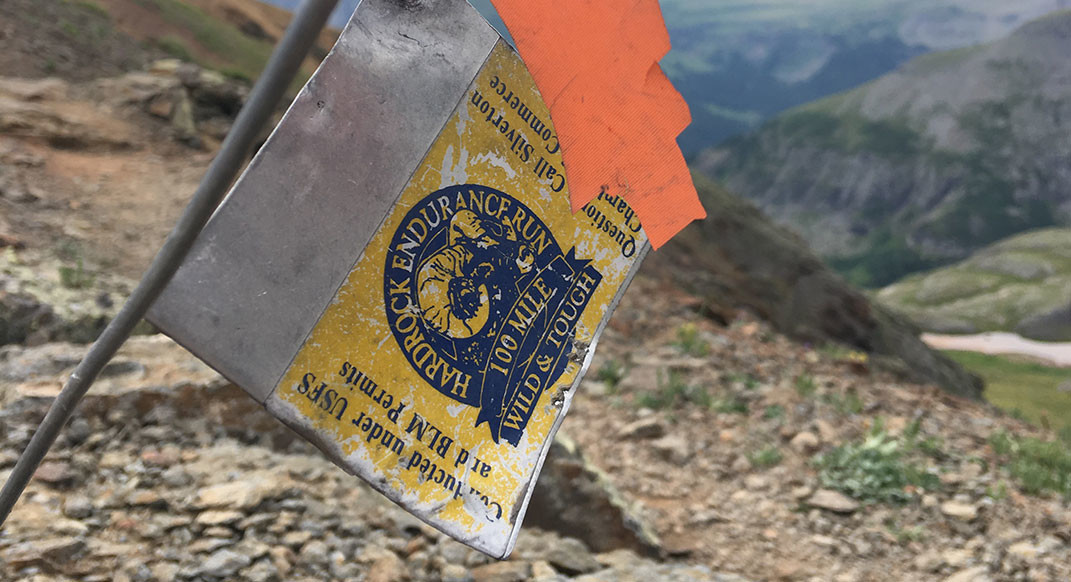
D’haene was one the favorites to win this year’s Hardrock 100 but will have to wait until next year to run for his first chance to kiss the rock, as this year’s run was canceled after a winter of heavy snow that resulted in avalanche debris making many sections of the 100.5-mile loop from Silverton to Telluride, Ouray and Lake City and back to Silverton impassable. There was also big concern about high water with a late runoff from the melting snow.
France’s D’haene, a four-time Ultra Trail du Mont Blanc champion and UTMB course record holder, had planned to spend time running in the San Juan Mountains to prepare for this year’s Hardrock, and he still traveled to Southwest Colorado despite the race cancellation that was announced June 10.
“François D’haene, in my mind, is probably the best runner on the planet in terms of consistency and skill at ultra-running,” Frost said. “He has so much experience. He had a baby boy and was coming for Hardrock and decided to still come anyway. He’s pretty dedicated to his commitment to coming for Hardrock.”
Garland has yet to meet D’haene in person and is eager for him to join the Hardrock community this weekend.
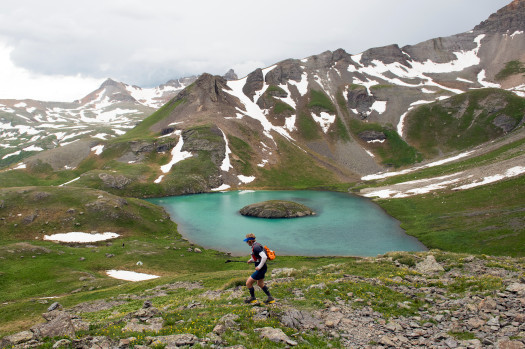
“It does mean a lot when somebody of his stature and with his prestige in the ultra-running community says, you know what, it’s worth it for me to not blow this thing off and rearrange my schedule, I’m still going to enjoy the San Juan Mountains and still gonna be part of the Hardrock community,” Garland said.
Durango’s Jones also will be in attendance along with representatives from Salomon running. Frost said there will be several gear giveaways as well as a donation box to benefit the Silverton community and help mitigate the economic impact of there not being a race this year.
“I know Salomon is doing a special work day on Monday, so they are giving back and being part of the community, which I think is really cool,” Garland said.
Login to leave a comment
Hardrock 100
100-mile run with 33,050 feet of climb and 33,050 feet of descent for a total elevation change of 66,100 feet with an average elevation of 11,186 feet - low point 7,680 feet (Ouray) and high point 14,048 feet (Handies Peak). The run starts and ends in Silverton, Colorado and travels through the towns of Telluride, Ouray, and the ghost town...
more...The 2019 Hardrock 100 has been cancelled due to historic snowfall effecting more than 40 percent of the course
Due to historic snowfall, avalanches, avalanche debris, an inability to reach certain aid stations and uncertain conditions on more than 40% of the course, the 2019 Hardrock Hundred Endurance Run has been canceled. This decision, while difficult, adheres to the Hardrock Hundred Endurance Run’s overall commitment to land stewardship and the safety of the Hardrock community.
The Hardrock Hundred Endurance Run committee’s decision to cancel the 2019 Hardrock Hundred Endurance Run was based on a thorough and complete evaluation of all available information and utilized a number of key resources to support its decision.
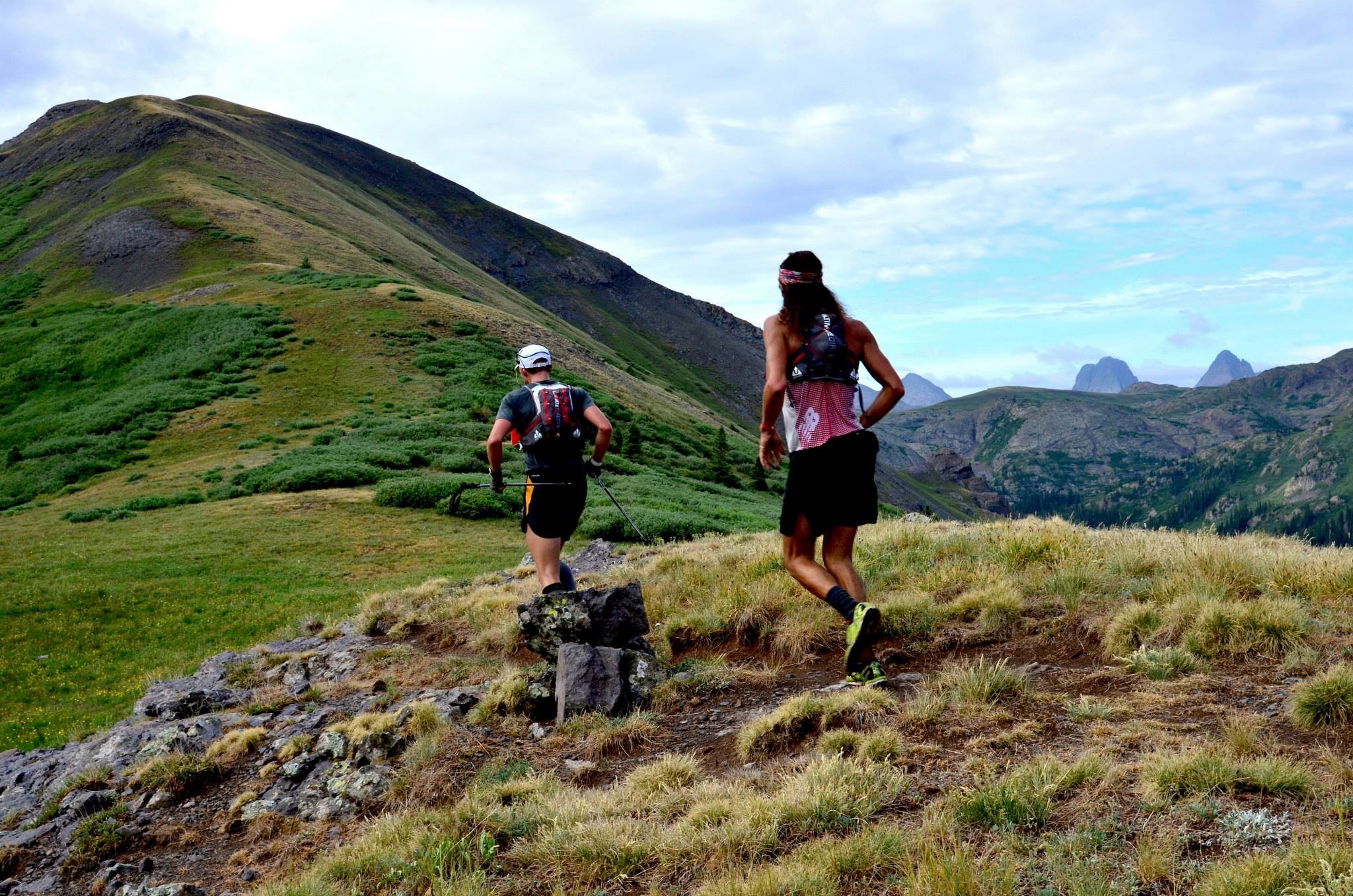
Firsthand course trail reconnaissance combined with assembled trail reports, key and valuable input from the Bureau of Land Management and the US Forestry Service and the Hardrock Hundred Endurance Run committee and Board of Directors all served to guide the decision-making process.
All runners who are entered in the 2019 Hardrock Hundred Endurance Run as of June 10th, 2019 will have the option of either rolling over their entry into the 2020 Hardrock Hundred Endurance Run or withdrawing their entry slot and receiving a full refund of their entry fee.
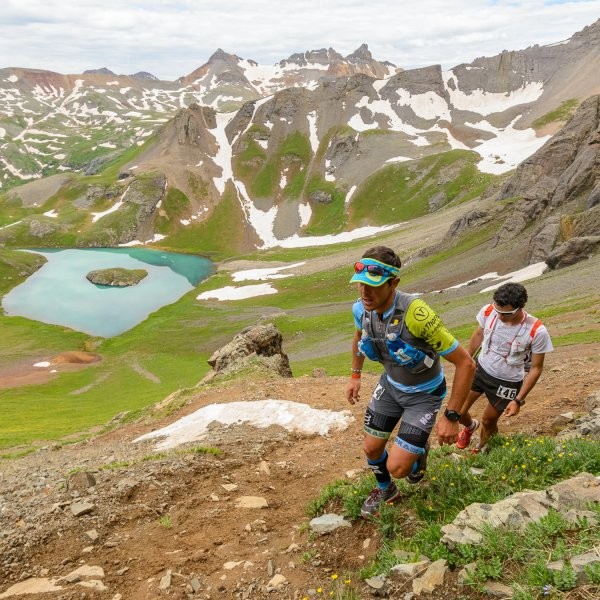
Entrants must notify the Run Director, Dale Garland, by email (dale@hardrock100.com) by July 12th, 2019 if they wish to withdraw; otherwise they will be considered to have elected to roll over their entry into the 2020 Hardrock Hundred Endurance Run.
“After an extensive process, it became clear that the uncertainty associated with the condition of the course and the issues that the uncertainty caused among our organizational components meant we could not organize and administer a safe and meaningful 2019 Hardrock Hundred Endurance Run that was consistent with the standards and values Hardrock has become known for,” said Run Director, Dale Garland.
“While snow and snow water equivalent levels looked to be dropping to manageable levels, other issues such as unprecedented avalanche debris, unstable snow bridges and high-water levels all contributed to us reaching the tough final decision that we did.”
The start date for the 2020 Hardrock will be July 17, 2020.
Login to leave a comment
Hardrock 100
100-mile run with 33,050 feet of climb and 33,050 feet of descent for a total elevation change of 66,100 feet with an average elevation of 11,186 feet - low point 7,680 feet (Ouray) and high point 14,048 feet (Handies Peak). The run starts and ends in Silverton, Colorado and travels through the towns of Telluride, Ouray, and the ghost town...
more...Jeff Browning just got into the 2018 Hardrock 100 ultra-marathon two weeks ago
Login to leave a comment
France’s Xavier Thévenard disqualified at Hardrock 100 with less than 10 miles to go
Login to leave a comment
All eyes on Xavier Thévenard for Hardrock 100
Login to leave a comment
Canadian trail ultrarunner Adam Campbell has withdrawn from the Hardrock 100
Login to leave a comment


